Social Work Research Methods That Drive the Practice

Social workers advocate for the well-being of individuals, families and communities. But how do social workers know what interventions are needed to help an individual? How do they assess whether a treatment plan is working? What do social workers use to write evidence-based policy?
Social work involves research-informed practice and practice-informed research. At every level, social workers need to know objective facts about the populations they serve, the efficacy of their interventions and the likelihood that their policies will improve lives. A variety of social work research methods make that possible.

Data-Driven Work
Data is a collection of facts used for reference and analysis. In a field as broad as social work, data comes in many forms.
Quantitative vs. Qualitative
As with any research, social work research involves both quantitative and qualitative studies.
Quantitative Research
Answers to questions like these can help social workers know about the populations they serve — or hope to serve in the future.
- How many students currently receive reduced-price school lunches in the local school district?
- How many hours per week does a specific individual consume digital media?
- How frequently did community members access a specific medical service last year?
Quantitative data — facts that can be measured and expressed numerically — are crucial for social work.
Quantitative research has advantages for social scientists. Such research can be more generalizable to large populations, as it uses specific sampling methods and lends itself to large datasets. It can provide important descriptive statistics about a specific population. Furthermore, by operationalizing variables, it can help social workers easily compare similar datasets with one another.
Qualitative Research
Qualitative data — facts that cannot be measured or expressed in terms of mere numbers or counts — offer rich insights into individuals, groups and societies. It can be collected via interviews and observations.
- What attitudes do students have toward the reduced-price school lunch program?
- What strategies do individuals use to moderate their weekly digital media consumption?
- What factors made community members more or less likely to access a specific medical service last year?
Qualitative research can thereby provide a textured view of social contexts and systems that may not have been possible with quantitative methods. Plus, it may even suggest new lines of inquiry for social work research.
Mixed Methods Research
Combining quantitative and qualitative methods into a single study is known as mixed methods research. This form of research has gained popularity in the study of social sciences, according to a 2019 report in the academic journal Theory and Society. Since quantitative and qualitative methods answer different questions, merging them into a single study can balance the limitations of each and potentially produce more in-depth findings.
However, mixed methods research is not without its drawbacks. Combining research methods increases the complexity of a study and generally requires a higher level of expertise to collect, analyze and interpret the data. It also requires a greater level of effort, time and often money.
The Importance of Research Design
Data-driven practice plays an essential role in social work. Unlike philanthropists and altruistic volunteers, social workers are obligated to operate from a scientific knowledge base.
To know whether their programs are effective, social workers must conduct research to determine results, aggregate those results into comprehensible data, analyze and interpret their findings, and use evidence to justify next steps.
Employing the proper design ensures that any evidence obtained during research enables social workers to reliably answer their research questions.
Research Methods in Social Work
The various social work research methods have specific benefits and limitations determined by context. Common research methods include surveys, program evaluations, needs assessments, randomized controlled trials, descriptive studies and single-system designs.
Surveys involve a hypothesis and a series of questions in order to test that hypothesis. Social work researchers will send out a survey, receive responses, aggregate the results, analyze the data, and form conclusions based on trends.
Surveys are one of the most common research methods social workers use — and for good reason. They tend to be relatively simple and are usually affordable. However, surveys generally require large participant groups, and self-reports from survey respondents are not always reliable.
Program Evaluations
Social workers ally with all sorts of programs: after-school programs, government initiatives, nonprofit projects and private programs, for example.
Crucially, social workers must evaluate a program’s effectiveness in order to determine whether the program is meeting its goals and what improvements can be made to better serve the program’s target population.
Evidence-based programming helps everyone save money and time, and comparing programs with one another can help social workers make decisions about how to structure new initiatives. Evaluating programs becomes complicated, however, when programs have multiple goal metrics, some of which may be vague or difficult to assess (e.g., “we aim to promote the well-being of our community”).
Needs Assessments
Social workers use needs assessments to identify services and necessities that a population lacks access to.
Common social work populations that researchers may perform needs assessments on include:
- People in a specific income group
- Everyone in a specific geographic region
- A specific ethnic group
- People in a specific age group
In the field, a social worker may use a combination of methods (e.g., surveys and descriptive studies) to learn more about a specific population or program. Social workers look for gaps between the actual context and a population’s or individual’s “wants” or desires.
For example, a social worker could conduct a needs assessment with an individual with cancer trying to navigate the complex medical-industrial system. The social worker may ask the client questions about the number of hours they spend scheduling doctor’s appointments, commuting and managing their many medications. After learning more about the specific client needs, the social worker can identify opportunities for improvements in an updated care plan.
In policy and program development, social workers conduct needs assessments to determine where and how to effect change on a much larger scale. Integral to social work at all levels, needs assessments reveal crucial information about a population’s needs to researchers, policymakers and other stakeholders. Needs assessments may fall short, however, in revealing the root causes of those needs (e.g., structural racism).
Randomized Controlled Trials
Randomized controlled trials are studies in which a randomly selected group is subjected to a variable (e.g., a specific stimulus or treatment) and a control group is not. Social workers then measure and compare the results of the randomized group with the control group in order to glean insights about the effectiveness of a particular intervention or treatment.
Randomized controlled trials are easily reproducible and highly measurable. They’re useful when results are easily quantifiable. However, this method is less helpful when results are not easily quantifiable (i.e., when rich data such as narratives and on-the-ground observations are needed).
Descriptive Studies
Descriptive studies immerse the researcher in another context or culture to study specific participant practices or ways of living. Descriptive studies, including descriptive ethnographic studies, may overlap with and include other research methods:
- Informant interviews
- Census data
- Observation
By using descriptive studies, researchers may glean a richer, deeper understanding of a nuanced culture or group on-site. The main limitations of this research method are that it tends to be time-consuming and expensive.
Single-System Designs
Unlike most medical studies, which involve testing a drug or treatment on two groups — an experimental group that receives the drug/treatment and a control group that does not — single-system designs allow researchers to study just one group (e.g., an individual or family).
Single-system designs typically entail studying a single group over a long period of time and may involve assessing the group’s response to multiple variables.
For example, consider a study on how media consumption affects a person’s mood. One way to test a hypothesis that consuming media correlates with low mood would be to observe two groups: a control group (no media) and an experimental group (two hours of media per day). When employing a single-system design, however, researchers would observe a single participant as they watch two hours of media per day for one week and then four hours per day of media the next week.
These designs allow researchers to test multiple variables over a longer period of time. However, similar to descriptive studies, single-system designs can be fairly time-consuming and costly.
Learn More About Social Work Research Methods
Social workers have the opportunity to improve the social environment by advocating for the vulnerable — including children, older adults and people with disabilities — and facilitating and developing resources and programs.
Learn more about how you can earn your Master of Social Work online at Virginia Commonwealth University . The highest-ranking school of social work in Virginia, VCU has a wide range of courses online. That means students can earn their degrees with the flexibility of learning at home. Learn more about how you can take your career in social work further with VCU.
From M.S.W. to LCSW: Understanding Your Career Path as a Social Worker
How Palliative Care Social Workers Support Patients With Terminal Illnesses
How to Become a Social Worker in Health Care
Gov.uk, Mixed Methods Study
MVS Open Press, Foundations of Social Work Research
Open Social Work Education, Scientific Inquiry in Social Work
Open Social Work, Graduate Research Methods in Social Work: A Project-Based Approach
Routledge, Research for Social Workers: An Introduction to Methods
SAGE Publications, Research Methods for Social Work: A Problem-Based Approach
Theory and Society, Mixed Methods Research: What It Is and What It Could Be
READY TO GET STARTED WITH OUR ONLINE M.S.W. PROGRAM FORMAT?
Bachelor’s degree is required.
- Search Menu
- Advance articles
- Author Guidelines
- Submission Site
- About Social Work Research
- National Association of Social Workers
- Editorial Board
- Advertising and Corporate Services
- Journals Career Network
- Self-Archiving Policy
- Dispatch Dates
- Journals on Oxford Academic
- Books on Oxford Academic

Editor-in-Chief
Robert L. Hawkins, PhD, MA, MPA
About the journal
Social Work Research publishes exemplary research to advance the development of knowledge and inform social work practice.
Latest articles
Latest posts on x.

Find a home for your paper

Content Collections
Explore these curated collections, which feature articles from all four of the NASW journals.
Politics & Social Justice Collection
Immigration & Social Work Collection
Mental Health Collection
2020 Social Work Month Collection
2019 Social Work Month Collection
Featured Article
Boston College Professor Robert Motley discusses the research he co-authored, "Prevalence and Correlates of Police Contact Anxiety among Male and Female Black Emerging Adults in St. Louis, Missouri."
Read the article
More Videos

Call for papers
The NASW journals are accepting manuscripts for upcoming special issues.

Discover a more complete picture of how readers engage with research in Social Work Research through Altmetric data. Now available on article pages.

Recommend to your library
Fill out our simple online form to recommend Social Work Research to your library.
Recommend now

Email alerts
Register to receive table of contents email alerts as soon as new issues of Social Work Research are published online.

Highly Cited Collection
Explore a collection of highly cited articles from the NASW journals published in 2020 and 2021.
Related Titles
- Recommend to your Library
Affiliations

- Online ISSN 1545-6838
- Print ISSN 1070-5309
- Copyright © 2024 National Association of Social Workers
- About Oxford Academic
- Publish journals with us
- University press partners
- What we publish
- New features
- Open access
- Institutional account management
- Rights and permissions
- Get help with access
- Accessibility
- Advertising
- Media enquiries
- Oxford University Press
- Oxford Languages
- University of Oxford
Oxford University Press is a department of the University of Oxford. It furthers the University's objective of excellence in research, scholarship, and education by publishing worldwide
- Copyright © 2024 Oxford University Press
- Cookie settings
- Cookie policy
- Privacy policy
- Legal notice
This Feature Is Available To Subscribers Only
Sign In or Create an Account
This PDF is available to Subscribers Only
For full access to this pdf, sign in to an existing account, or purchase an annual subscription.

Foundations of Social Work Research
(4 reviews)
Rebecca L. Mauldin
Copyright Year: 2020
ISBN 13: 9781648169915
Publisher: Mavs Open Press
Language: English
Formats Available
Conditions of use.
Learn more about reviews.
Reviewed by LaToya Smith-Jones, Adjunct Professor, University of Texas at Arlington on 3/26/24
The textbook covers various topics that are familiar to the Social Work profession. There are relatable examples given within the book, which allow Social Work students to understand discussions through the lens of an actual practitioner. Each... read more
Comprehensiveness rating: 5 see less
The textbook covers various topics that are familiar to the Social Work profession. There are relatable examples given within the book, which allow Social Work students to understand discussions through the lens of an actual practitioner. Each section provides an area where research vocabulary is listed and reviewed, as well as examples to deepen the understanding of the vocabulary used.
Content Accuracy rating: 5
The information presented in the textbook is presented with accuracy. Bias was not noticed within the text.
Relevance/Longevity rating: 5
The information presented within the textbook was up-to-date. Classical studies were also included in the textbook. The classical studies allow the students to understand the historical influence regarding the research process.
Clarity rating: 5
The textbook provides examples and a separate vocabulary section in order to understand the jargon and technical terminology. individuals who do not have a research background will be able to comprehend the information written.
Consistency rating: 5
The textbook is consistent regarding terminology and framework. Each section builds upon the previous section.
Modularity rating: 5
Each section is broken up according to the topic of the chapter. Each chapter is broken up in sections, which allows for an easier read.
Organization/Structure/Flow rating: 5
The chapters are presented in a logical and clear fashion. The information presented within the textbook builds upon itself. Students are first introduced to background information regarding the topic and then they are given information regarding the application of the information shared.
Interface rating: 5
There were not any interface issues.
Grammatical Errors rating: 5
There were not any grammatical errors noted.
Cultural Relevance rating: 5
Information within the text was inclusive and included examples of various ethnicities and backgrounds.
The textbook is excellent to use for students who do not have a research background. The manner in which the information is presented and laid out assists with aiding students' understanding.
Reviewed by Quentin Maynard, Assistant Professor, University of Southern Indiana on 11/30/22
This text covers topics that social work students need to understand to be consumers of research. The author and contributors include current real work examples to help emphasize the different topics. Integrating the chapter on Real World Research... read more
This text covers topics that social work students need to understand to be consumers of research. The author and contributors include current real work examples to help emphasize the different topics. Integrating the chapter on Real World Research throughout the text might help emphasize to students that engaging in research is necessary to our profession, even as practitioners.
The content was accurate and error-free.
The content of the text was up-to-date and included information relevant to social work research. Since the main author solicited contributions from colleagues at their institution, updates and changes would likely be relatively straightforward.
The book seemed accessible for individuals with limited research experience. Key words were defined in the text and included in a glossary at the end of each section and the text.
The text was consistent in style and organization. Chapter subsections have specific learning objectives allowing students to know what will be covered in each chapter. Doing this reduces bloat and increases clarity for readers.
The text did not appear to be structured in a way that was overwhelming or difficult to follow.
The structure of the book was logical.
The digital pdf and the online versions of the text were intuitive and easy to navigate. I did not notice any issues with the interface in either format.
No writing or grammar errors noted.
The text is culturally sensitive. It includes a content advisory at the beginning of each chapter which allows students to be aware of specific topics (e.g., racism, sexism, and poverty) discussed or mentioned in the chapter. While this text was adapted for students at a specific university, the authors include topics that reach much farther than that audience. The examples included cover a diverse set of people and situations.
This is a comprehensive text that allows students the opportunity to learn how to be consumers of social work research. While practice evaluation might not be the scope of this text, other than the chapter on Real World Research, including discussions about how students might apply the concepts of each chapter in social work practice. The structure of the book allows students to see the research that their professors are engaging in and might make research more accessible to social work students and practitioners
Reviewed by Matt Walsh, Assistant Professor of Social Work, Marian University on 12/30/21
This textbook covers all the aspects of research you would expect for an introduction to social work research. It uses classic examples of past research to highlight the importance of ethics in research. It also does a good job of discussing... read more
This textbook covers all the aspects of research you would expect for an introduction to social work research. It uses classic examples of past research to highlight the importance of ethics in research. It also does a good job of discussing both quantitative and qualitative research as well as single system designs and program evaluation. My one critique as someone who does qualitative research is that it mentions the importance of trustworthiness and rigor in qualitative research but does not mention how a research can achieve this. However, it does go into other elements like coding and it would not be hard to provide student with supplemental materials about memoing or peer debriefing as examples and to be fair, it is hard to put everything in just one chapter.
All components are accurately described and well-written. The glossary at the end of each section is helpful for key words. The text appears to be error-free and unbiased.
There are links to recent examples which highlights the real world aspect of research.
This text is clear in its description of research and its major components. Certain aspects like causality get a little advanced for a introduction to research book but there are good visual to aid in students' understanding of some of the more complicated concepts. (Please note that I am reviewing this with BSW students in mind, MSW students may not find some of these sections as overwhelming as I suspect my students might).
The book is very well structured and consistent throughout.
The text is well structured and organized as a whole and in terms of each chapter and each section with the chapters.
The topics follow the order of most other foundational research books I have seen and have a logical flow to them.
I did not find any interface issues.
I could not see any grammatical errors.
There are good examples throughout that display an effort to have inclusivity, diversity, and equity in this text.
I feel like this book would provide students with a good understanding about research and could be used interchangeably with other foundational/introduction books on the market, especially if the professor is familiar with teaching research and has already established a good foundation (quizzes, lecture slides, assignments, activities, etc.).
Reviewed by Vivian Miller, Assistant Professor in Social Work, Bowling Green State University on 1/5/21
The text Foundations of Social Work Research covers social work research comprehensively and appropriately. Across twelve chapters, the author begins by introducing research, the science behind research and how this translates to the profession of... read more
The text Foundations of Social Work Research covers social work research comprehensively and appropriately. Across twelve chapters, the author begins by introducing research, the science behind research and how this translates to the profession of social work, and the importance of understanding research as it applies to social work practice across all system levels. In addition to comprehensive chapters, the text contains a glossary, practice behavior indices, bibliography, derivative notes, and links by each chapter.
This text is an accurate text that is error free. This text is extremely well-written and includes real-life examples, drawing on written contributions from social work faculty across practice settings and populations, as well as students at the masters and doctoral levels.
Much of research methods and the process is overall static, however the author does an incredible job to provide timely, relevant, and applicable examples throughout the text to ensure that this version will not be obsolete within a short period of time.
This text is clearly written and is easy to move through. This text contains chapters and sub-chapters. I’d recommend this book for a higher-level undergraduate program or graduate program (e.g., MSW), as there is technical terminology used. Additionally, the author provides a glossary at the back of the text, hyperlinked to each chapter on the web-version. Moreover, there are definitions highlighted at center page throughout the text.
This text is very consistent. Chapters build on one another and are written in clear order.
The use of subheadings throughout allows this text to be separated into smaller reading sections. For instance, if an instructor wanted to assign reading for “Probability sampling,” this topic can be readily extracted from the full text. A student can understand this topic area despite being separated from the text as context is provided to the reader in each sub-chapter. The use of bolded words, images, examples, and hyperlinks throughout make the text easy to separate and digest.
This text is very well-organized and moves through each section in a step-wise process building on each previous content area.
There are no interface issues in the text. Images display well, as well as key takeaway and glossary charts throughout each chapter.
The text contains no grammatical errors.
This text is culturally sensitive. Examples across all system levels (e.g., micro, messo, and macro) are inclusive of a variety of races, ethnicities, and backgrounds.
Highly recommend this text for a Social Work research course.
Table of Contents
- Chapter One: Introduction to research
- Chapter Two: Linking methods with theory
- Chapter Three: Ethics in social work research
- Chapter Four: Design and causality
- Chapter Five: Defining and measuring concepts
- Chapter Six: Sampling
- Chapter Seven: Survey research
- Chapter Eight: Experimental design
- Chapter Nine: Unique features of qualitative research
- Chapter Ten: Unobtrusive research
- Chapter Eleven: Real-world research
- Chapter Twelve: Reporting research
Ancillary Material
About the book.
This textbook was created to provide an introduction to research methods for BSW and MSW students, with particular emphasis on research and practice relevant to students at the University of Texas at Arlington. It provides an introduction to social work students to help evaluate research for evidence-based practice and design social work research projects. It can be used with its companion, A Guidebook for Social Work Literature Reviews and Research Questions by Rebecca L. Mauldin and Matthew DeCarlo, or as a stand-alone textbook.
About the Contributors
Rebecca L. Mauldin , Ph.D
Contribute to this Page

Want to create or adapt books like this? Learn more about how Pressbooks supports open publishing practices.
1 1. Science and social work
Chapter outline.
- How do social workers know what to do? (12 minute read time)
- The scientific method (16 minute read time)
- Evidence-based practice (11 minute read time)
- Social work research (10 minute read time)
Content warning: Examples in this chapter contain references to school discipline, child abuse, food insecurity, homelessness, poverty and anti-poverty stigma, anti-vaccination pseudoscience, autism, trauma and PTSD, mental health stigma, susto and culture-bound syndromes, gender-based discrimination at work, homelessness, psychiatric hospitalizations, substance use, and mandatory treatment.
1.1 How do social workers know what to do?
Learning objectives.
Learners will be able to…
- Reflect on how we, as social workers, make decisions
- Differentiate between micro-, meso-, and macro-level analysis
- Describe the concept of intuition, its purpose in social work, and its limitations
- Identify specific errors in thinking and reasoning
What would you do?
Case 1: Imagine you are a clinical social worker at a children’s mental health agency. One day, you receive a referral from your town’s middle school about a client who often skips school, gets into fights, and is disruptive in class. The school has suspended him and met with the parents on multiple occasions, who say they practice strict discipline at home. Yet the client’s behavior has worsened. When you arrive at the school to meet with your client, who is also a gifted artist, you notice he seems to have bruises on his legs, has difficulty maintaining eye contact, and appears distracted. Despite this, he spends the hour painting and drawing, during which time you are able to observe him.
- Given your observations of your client’s strengths and challenges, what intervention would you select, and how could you determine its effectiveness?
Case 2: Imagine you are a social worker working in the midst of an urban food desert (a geographic area in which there is no grocery store that sells fresh food). As a result, many of your low-income clients either eat takeout, or rely on food from the dollar store or a convenience store. You are becoming concerned about your clients’ health, as many of them are obese and say they are unable to buy fresh food. Your clients tell you that they have to rely on food pantries because convenience stores are expensive and often don’t have the right kinds of food for their families. You have spent the past month building a coalition of community members to lobby your city council. The coalition includes individuals from non-profit agencies, religious groups, and healthcare workers.
- How should this group address the impact of food deserts in your community? What intervention(s) do you suggest? How would you determine whether your intervention was effective?
Case 3: You are a social worker working at a public policy center whose work focuses on the issue of homelessness. Your city is seeking a large federal grant to address this growing problem and has hired you as a consultant to work on the grant proposal. After interviewing individuals who are homeless and conducting a needs assessment in collaboration with local social service agencies, you meet with city council members to talk about potential opportunities for intervention. Local agencies want to spend the money to increase the capacity of existing shelters in the community. In addition, they want to create a transitional housing program at an unused apartment complex where people can reside upon leaving the shelter, and where they can gain independent living skills. On the other hand, homeless individuals you interview indicate that they would prefer to receive housing vouchers to rent an apartment in the community. They also fear the agencies running the shelter and transitional housing program would impose restrictions and unnecessary rules and regulations, thereby curbing their ability to freely live their lives. When you ask the agencies about these client concerns, they state that these clients need the structure and supervision provided by agency support workers.
- Which kind of program should your city choose to implement? Which is most likely to be effective and why?
Assuming you’ve taken a social work course before, you will notice that these case studies cover different levels of analysis in the social ecosystem—micro, meso, and macro. At the micro-level , social workers examine the smallest levels of interaction; in some cases, just “the self” alone (e.g. the child in case one).
When social workers investigate groups and communities, such as our food desert in case 2, their inquiry is at the meso-level .
At the macro-level , social workers examine social structures and institutions. Research at the macro-level examines large-scale patterns, including culture and government policy.
These three domains interact with one another, and it is common for a research project to address more than one level of analysis. For example, you may have a study about individuals at a case management agency (a micro-level study) that impacts the organization as a whole (meso-level) and incorporates policies and cultural issues (macro-level). Moreover, research that occurs on one level is likely to have multiple implications across domains.
How do social workers know what to do?
Welcome to social work research. This chapter begins with three problems that social workers might face in practice, and three questions about what a social worker should do next. If you haven’t already, spend a minute or two thinking about the three aforementioned cases and jot down some notes. How might you respond to each of these cases?

I assume it is unlikely you are an expert in the areas of children’s mental health, community responses to food deserts, and homelessness policy. Don’t worry, I’m not either. In fact, for many of you, this textbook will likely come at an early point in your graduate social work education, so it may seem unfair for me to ask you what the ‘right’ answers are. And to disappoint you further, this course will not teach you the ‘right’ answer to these questions. It will, however, teach you how to answer these questions for yourself, and to find the ‘right’ answer that works best in each unique situation.
Assuming you are not an experienced practitioner in the areas described above, you likely used intuition (Cheung, 2016). [1] when thinking about what you would do in each of these scenarios. Intuition is a “gut feeling” about what to think about and do, often based on personal experience. What we experience influences how we perceive the world. For example, if you’ve witnessed representations of trauma in your practice, personal life, or in movies or television, you may have perceived that the child in case one was being physically abused and that his behavior was a sign of trauma. As you think about problems such as those described above, you find that certain details stay with you and influence your thinking to a greater degree than others. Using past experiences, you apply seemingly relevant knowledge and make predictions about what might be true.
Over a social worker’s career, intuition evolves into practice wisdom . Practice wisdom is the “learning by doing” that develops as a result of practice experience. For example, a clinical social worker may have a “feel” for why certain clients would be a good fit to join a particular therapy group. This idea may be informed by direct experience with similar situations, reflections on previous experiences, and any consultation they receive from colleagues and/or supervisors. This “feel” that social workers get for their practice is a useful and valid source of knowledge and decision-makin – do not discount it.
On the other hand, intuitive thinking can be prone to a number of errors. We are all limited in terms of what we know and experience. One’s economic, social, and cultural background will shape intuition, and acting on your intuition may not work in a different sociocultural context. Because you cannot learn everything there is to know before you start your career as a social worker, it is important to learn how to understand and use social science to help you make sense of the world and to help you make sound, reasoned, and well-thought out decisions.
Social workers must learn how to take their intuition and deepen or challenge it by engaging with scientific literature. Similarly, social work researchers engage in research to make certain their interventions are effective and efficient (see Section 1.4 for more information). Both of these processes–consuming and producing research–inform the social justice mission of social work. That’s why the Council on Social Work Education (CSWE), who accredits the MSW program you are in, requires that you engage in social science.
Competency 4: Engage In Practice-informed Research and Research-informed Practice Social workers understand quantitative and qualitative research methods and their respective roles in advancing a science of social work and in evaluating their practice. Social workers know the principles of logic, scientific inquiry, and culturally informed and ethical approaches to building knowledge. Social workers understand that evidence that informs practice derives from multi-disciplinary sources and multiple ways of knowing. They also understand the processes for translating research findings into effective practice. Social workers: • use practice experience and theory to inform scientific inquiry and research; • apply critical thinking to engage in analysis of quantitative and qualitative research methods and research findings; and • use and translate research evidence to inform and improve practice, policy, and service delivery. (CSWE, 2015). [2]
Errors in thinking
We all rely on mental shortcuts to help us figure out what to do in a practice situation. All people, including you and me, must train our minds to be aware of predictable flaws in thinking, termed cognitive biases . Here is a link to the Wikipedia entry on cognitive biases, as well as an interactive list . As you can see, there are many types of biases that can results in irrational conclusions.
The most important error in thinking for social scientists to be aware of is the concept of confirmation bias . Confirmation bias involves observing and analyzing information in a way that confirms what you already believe to be true. We all arrive at each moment with a set of personal beliefs, experiences, and worldviews that have been developed and ingrained over time. These patterns of thought inform our intuitions, primarily in an unconscious manner. Confirmation bias occurs when our mind ignores or manipulates information to avoid challenging what we already believe to be true.
In our second case study, we are trying to figure out how to help people who receive SNAP (sometimes referred to as Food Stamps) who live in a food desert. Let’s say we have arrived at a policy solution and are now lobbying the city council to implement it. There are many who have negative beliefs about people who are “on welfare.” These people may believe individuals who receive social welfare benefits spend their money irresponsibly, are too lazy to get a job, and manipulate the system to maintain or increase their government payout.
Those espousing this belief may point to an example such as Louis Cuff , who bought steak and lobster with his SNAP benefits and resold them for a profit. However, they are falling prey to assuming that one person’s bad behavior reflects upon an entire group of people. City council members who hold these beliefs may ignore the truth about the client population—that people experiencing poverty usually spend their money responsibly and that they genuinely need help accessing fresh and healthy food. In this way, confirmation bias often makes people less capable of empathizing with one another because they have difficulty accepting alternative perspectives.

Errors in reasoning
Because the human mind is prone to errors, when anyone makes a statement about what is true or what should be done in a given situation, errors in logic may abound. Think back to the case studies at the beginning of this section. You most likely had some ideas about what to do in each case. Below are some of the most common logical fallacies and the ways in which they may negatively influence a social worker:
- Making hasty generalization : when a person draws conclusions before having enough information. A social worker may apply lessons from a handful of clients to an entire population of people (see Louis Cuff , above). It is important to examine the scientific literature in order to avoid this.
- Confusing correlation with causation : when one concludes that because two things are correlated (as one changes, the other changes), they must be causally related. As an example, a social worker might observe both an increase in the minimum wage and higher unemployment in certain areas of the city. However, just because two things changed at the same time does not mean they are causally related. Social workers should explore other factors that might impact causality.
- Going down a slippery slope : when a person concludes that we should not do something because something far worse will happen if we do so. For example, a social worker may seek to increase a client’s opportunity to choose their own activities, but face opposition from those who believe it will lead to clients making unreasonable demands. Clearly, this is nonsense. Changes that foster self-determination are unlikely to result in client revolt. Social workers should be skeptical of arguments opposing small changes because one argues that radical changes are inevitable.
- Appealing to authority : when a person draws a conclusion by appealing to the authority of an expert or reputable individual, rather than through the strength of the claim. You have likely encountered individuals who believe they are correct because another in a position of authority told them so. Instead, we should work to build a reflective and critical approach to practice that questions authority.
- Hopping on the bandwagon : when a person draws a conclusion consistent with popular belief. Just because something is popular does not mean it is correct. Fashionable ideas come and go. Social workers should engage with trendy ideas but must ground their work in scientific evidence rather than popular opinion.
- Using a straw man : when a person does not represent their opponent’s position fairly or with sufficient depth. For example, a social worker advocating for a new group home may depict homeowners that are opposed to clients living in their neighborhood as individuals concerned only with their property values. However, this may not be the case. Social workers should instead engage deeply with all sides of an issue and represent them accurately.
Key Takeaways
- Social work research occurs at the micro-, meso-, and macro-level.
- Intuition is a powerful, though limited, source of information when making decisions.
- All human thought is subject to errors in thinking and reasoning.
- Scientific inquiry accounts for cognitive biases by applying an organized, logical way of observing and theorizing about the world.
- Think about a social work topic you might want to study this semester as part of a research project. How do individuals commit specific errors in logic or reasoning when discussing a specific topic (e.g. Louis Cuff)? How can using scientific evidence help you combat popular myths that are based on erroneous thinking?
- Reflect on the strengths and limitations of your personal experiences as a way to guide your work with diverse populations. Describe an instance when your intuition may have resulted in biased or misguided thinking or behavior in a social work practice situation.
1.2 The scientific method
Learning objectives.
- Define science and social science
- Describe the differences between objective and subjective truth(s)
- Identify how qualitative and quantitative data are analyzed differently and how they can be used together
- Delineate the features of science that distinguish it from pseudoscience
If I asked you to draw a picture of science, what would you draw? My guess is it would be something from a chemistry or biology classroom, like a microscope or a beaker. Maybe something from a science fiction movie. All social workers use scientific thinking in their practice. However, social workers have a unique understanding of what science means, one that is (not surprisingly) more open to the unexpected and human side of the social world.
Science and not-science
In social work, science is a way of ‘knowing’ that attempts to systematically collect and categorize facts or truths. A key word here is systematically –conducting science is a deliberate process. Scientists gather information about facts in a way that is organized and intentional, and usually follows a set of predetermined steps. Social work is not a science, but social work is informed by social science ; the science of humanity, social interactions, and social structures. In other words, social work research uses organized and intentional procedures to uncover facts or truths about the social world. And social workers rely on social scientific research to promote change.

Science can also be thought of in terms of its impostor, pseudoscience. Pseudoscience refers to beliefs about the social world that are unsupported by scientific evidence. These claims are often presented as though they are based on science. But once researchers test them scientifically, they are demonstrated to be false. A scientifically uninformed social work practitioner using pseudoscience may recommend any number of ineffective, misguided, or harmful interventions. Pseudoscience often relies on information and scholarship that has not been reviewed by experts or offers a selective and biased reading of reviewed literature.
An example of pseudoscience comes from anti-vaccination activists. Despite overwhelming scientific consensus that vaccines do not cause autism, a very vocal minority of people continue to believe that they do. Anti-vaccination advocates present their information as based in science, as seen here at Green Med Info . The author of this website shares real abstracts from scientific journal articles and studies but will only provide information on articles that show the potential dangers of vaccines, without showing any research that prevents the positive and safe side of vaccines. Green Med Info is an example of confirmation bias, as all data presented on the website supports what the pseudo-scientific researcher believes to be true. For more information on assessing causal relationships, consult Chapter 6 , where we discuss causality in detail.
The values and practices associated with the scientific method work to overcome common errors in thinking (such as confirmation bias). First, the scientific method uses established techniques from the literature to determine the likelihood of something being true or false. The research process often cites these techniques, reasons for their use, and how researchers came to the decision to use said techniques. However, each technique comes with its own strengths and limitations. Rigorous science is about making the best choice, being open about your process, and allowing others to check your work. It is important to remember that there is no “perfect” study – all research has limitations because all scientific methods come with limitations.
Skepticism and debate
Unfortunately, the “perfect” researcher does not exist. Scientists are human, so they are subject to error and bias, such as gravitating toward fashionable ideas and thinking their work is more important than others’ work. Theories and concepts fade in and out of use and may be tossed aside when new evidence challenges their truth. Part of the challenge in your research projects will be finding what you believe about an issue, rather than summarizing what others think about the topic. Good science, just like good social work practice, is authentic. When I see students present their research projects, those that are the strongest deliver both passionate and informed arguments about their topic area.
Good science is also open to ongoing questioning. Scientists are fundamentally skeptical. As such, they are likely to pursue alternative explanations. They might question the design of a study or replicate it to see if it works in another context. Scientists debate what is true until they arrive at a majority consensus. If you’ve ever heard that 97% of climate scientists agree that global warming is due to human activity [3] or that 99% of economists agree that tariffs make the economy worse [4] , you are seeing this sociology of science in action. This skepticism will help to catch situations in which scientists who make the oh-so-human mistakes in thinking and reasoning reviewed in Section 1.1.
Skepticism also helps to identify unethical scientists, as with Andrew Wakefield’s study linking the MMR vaccination and autism. When other researchers looked at his data, they found that he had altered the data to match his own conclusions and sought to benefit financially from the ensuing panic about vaccination (Godlee, Smith, & Marcovitch, 2011). [5] This highlights another key value in science: openness.
Through the use of publications and presentations, scientists share the methods used to gather and analyze data. The trend towards open science has also prompted researchers to share data as well. This in turn enables other researchers to re-run, replicate, and validate analyses and results. A major barrier to openness in science is the paywall. When you’ve searched online for a journal article (we will review search techniques in Chapter 3), you have likely run into the $25-$50 price tag. Don’t despair – your university should subscribe to these journals. However, the push towards openness in science means that more researchers are sharing their work in open access journals, which are free for people to access (like this textbook!). These open access journals do not require a university subscription to view.
Openness also means engaging the broader public about your study. Social work researchers conduct studies to help people, and part of scientific work is making sure your study has an impact. For example, it is likely that many of the authors publishing in scientific journals are on Twitter or other social media platforms, relaying the importance of study findings. They may create content for popular media, including newspapers, websites, blogs, or podcasts. It may lead to training for agency workers or public administrators. Regrettably, academic researchers have a reputation for being aloof and disengaged from the public conversation. However, this reputation is slowly changing with the trend towards public scholarship and engagement. For example, see this recent section of the Journal of the Society of Social Work and Research on public impact scholarship .
Science supported by empirical data
Pseudoscience is often doctored up to look like science, but the surety with which its advocates speak is not backed up by empirical data. Empirical data refers to information about the social world gathered and analyzed through scientific observation or experimentation. Theory is also an important part of science, as we will discuss in Chapter 5 . However, theories must be supported by empirical data–evidence that what we think is true really exists in the world.
There are two types of empirical data that social workers should become familiar with. Quantitative data refers to numbers and qualitative data usually refers to word data (like a transcript of an interview) but can also refer to pictures, performances, and other means of expressing oneself. Researchers use specific methods designed to analyze each type of data. Together, these are known as research methods , or the methods researchers use to examine empirical data.
Objective truth
In our vaccine example, scientists have conducted many studies tracking children who were vaccinated to look for future diagnoses of autism (see Taylor et al. 2014 for a review). This is an example of using quantitative data to determine whether there is a causal relationship between vaccination and autism. By examining the number of people who develop autism after vaccinations and controlling for all of the other possible causes, researchers can determine the likelihood of whether vaccinations cause changes in the brain that are eventually diagnosed as autism.
In this case, the use of quantitative data is a good fit for disproving myths about the dangers of vaccination. When researchers analyze quantitative data, they are trying to establish an objective truth. An objective truth is always true, regardless of context. Generally speaking, researchers seeking to establish objective truth tend to use quantitative data because they believe numbers don’t lie. If repeated statistical analyses don’t show a relationship between two variables, like vaccines and autism, that relationship almost certainly does not exist. By boiling everything down to numbers, we can minimize the biases and logical errors that human researchers bring to the scientific process. That said, the interpretation of those numbers is always up for debate. That process can be subjective.
This approach to finding truth probably sounds similar to something you heard in your middle school science classes. When you learned about gravitational force or the mitochondria of a cell, you were learning about the theories and observations that make up our understanding of the physical world. We assume that gravity is real and that the mitochondria of a cell are real. Mitochondria are easy to spot with a powerful microscope and we can observe and theorize about their function in a cell. The gravitational force is invisible, but clearly apparent from observable facts, such as watching an apple fall. If we were unable to perceive mitochondria or gravity, they would still be there, doing their thing, because they exist independent of our observation of them.
Let’s consider a social work example. Scientific research has established that children who are subjected to severely traumatic experiences are more likely to be diagnosed with a mental health disorder (e.g., Mahoney, Karatzias, & Hutton, 2019). [6] A diagnosis of post-traumatic stress disorder (PTSD) is considered objective, and may refer to a mental health issue that exists independent of the individual observing it and is highly similar in its presentation across clients. The Diagnostic and Statistical Manual of Mental Disorders (DSM-5, 2017) [7] identifies a group of criteria which is based on unbiased, neutral client observations. These criteria are based in research, and render an objective diagnosis more likely to be valid and reliable. Through the clinician’s observations and the client’s description of their symptoms, an objective determination of a mental health diagnosis can be made.
Subjective truth(s)
For those of you skeptics, you may ask yourself: but does a diagnosis tell a client’s whole story? No. It does not tell you what the client thinks and feels about their diagnosis, for example. Receiving a diagnosis of PTSD may be a relief for a client. The diagnosis may suggest the words to describe their experiences. In addition, this diagnosis may provide a direction for therapeutic work, as there are evidence-based interventions clinicians can use with each diagnosis. On the other hand, a client may feel shame and view the diagnosis as a label, defining them in a negative way and limiting their potential (Barsky, 2015). [8]
Imagine if we surveyed people with PTSD to see how they interpreted their diagnosis. Objectively, we could determine whether more people said the diagnosis was, overall, a positive or negative event for them. However, it is unlikely that the experience of receiving a diagnosis was either completely positive or completely negative. In social work, we know that a client’s thoughts and emotions are rarely binary, either/or situations. Clients likely feel a mix of positive and negative thoughts and emotions during the diagnostic process. These messy bits are subjective truths , or the thoughts and feelings that arise as people interpret and make meaning of situations. Uniquely, looking for subjective truths can help us see the contradictory and multi-faceted nature of people’s thoughts, and qualitative data allows us to avoid oversimplifying them into negative and positive feelings that could be counted, as in quantitative data. It is the role of a researcher, just like a practitioner, to seek to understand things from the perspective of the client. Unlike with objective truth, this will not lead to a general sense of what is true for everyone, but rather what is true for that one person.
Subjective truths are best expressed through qualitative data, or through the use of words (not numbers). For example, we might invite a client to tell us how they felt after they were first diagnosed, after they spoke with family, and over the course of the therapeutic process. While it may look different from what we normally think of as science (e.g. pharmaceutical studies), these stories are indeed a rich source of data for scientific analysis. However, it is impossible to analyze what this client said without also considering the sociocultural context in which they live. For example, the concept of PTSD is generated from Western thought and philosophy. How might people from other cultures understand trauma differently?
In the DSM-5 classification of mental health disorders, there is a list of culture-bound syndromes which appear only in certain cultures. For example, susto describes a unique cluster of symptoms experienced by Latin Americans after a traumatic event (Nogueira, Mari, & Razzouk, 2015). [9] Susto involves more physical symptoms than a traditional PTSD diagnosis. Indeed, many of these syndromes do not fit within a Western conceptualization of mental health because they differentiate less between the mind and body. To a Western scientist, susto may seem less real than PTSD. To someone from Latin America, their symptoms may not fit neatly into the PTSD framework developed in Western nations . Science has historically privileged knowledge from the United States and other nations in the West and Global North , marking them as objectively true. The objectivity of Western science as universally applicable to all cultures has been increasingly called into question as science has become less dominated by white males, and interaction between cultures and groups becomes broadly more democratic. Clearly, what is true depends in part on the context in which it is observed.
In this way, social scientists have a unique task. People are both objects and subjects. Objectively, you could quantify how tall a person is, what car they drive, how many adverse childhood experiences they had, or their score on a PTSD checklist. Subjectively, you could understand how a person made sense of a traumatic incident or how it contributed to certain patterns in thinking, negative feelings, or opportunities for growth, for example. It is this added dimension that renders social science unique to natural science, which focuses almost exclusively on quantitative data and objective truth. For this reason, this book is divided between projects using qualitative data and quantitative data.
There is no “better” or “more true” way of approaching social science. Instead, the methods a researcher chooses should match the question they ask. If you want to answer, “do vaccines cause autism?” you should choose methods appropriate to answer that question. It seeks an objective truth–one that is true for everyone, regardless of context. Studies like these use quantitative data and statistical analyses to test mathematical relationships between variables. If, on the other hand, you wanted to know “what does a diagnosis of PTSD mean to clients?” you should collect qualitative data and seek subjective truths. You will gather stories and experiences from clients and interpret them in a way that best represents their unique and shared truths. Where there is consensus, you will report that. Where there is contradiction, you will report that as well.
Mixed methods
In this textbook, we will treat quantitative and qualitative research methods separately. However, it is important to remember that a project can include both approaches. A mixed methods study, which we will discuss more in chapter 6, requires thinking through a more complicated project that includes at least one quantitative component, one qualitative component, and a plan to incorporate both approaches together. As a result, mixed methods projects may require more time for conceptualization, data collection, and analysis.

Finding patterns
Regardless of whether you are seeking objective or subjective truths, research and scientific inquiry aim to find and explain patterns. Most of the time, a pattern will not explain every single person’s experience, a fact about social science that is both fascinating and frustrating. Even individuals who do not know each other can create patterns that persist over time. Those new to social science may find these patterns frustrating because they may believe that the patterns describing their sex, age, or some other facet of their lives don’t represent their experience. It’s true. A pattern can exist among your cohort without your individual participation in it. There is diversity within diversity.
Let’s consider some specific examples. You probably wouldn’t be surprised to learn that a person’s social class background has an impact on their educational attainment and achievement. You may be surprised to learn that people select romantic partners that have similar educational attainment, which in turn, impacts their children’s educational attainment (Eika, Mogstad, & Zafar, 2019). [10] . People who have graduated college pair off with other college graduates, as so forth. This, in turn, reinforces existing inequalities, stratifying society by those who have the opportunity to complete college and those who don’t.
People who object to these findings tend to cite evidence from their own personal experience. However, the problem with this response is that objecting to a social pattern on the grounds that it doesn’t match one’s individual experience misses the point about patterns. Patterns don’t perfectly predict what will happen to an individual person. Yet, they are a reasonable guide that, when systematically observed, can help guide social work thought and action. When we don’t investigate these patterns scientifically, we are subject to developing stereotypes, biases, and other harmful beliefs.
A final note on qualitative and quantitative methods
There is not one superior way to find patterns that help us understand the world. As we will learn about in Chapter 5 , there are multiple philosophical, theoretical, and methodological ways to approach scientific truth. Qualitative methods aim to provide an in-depth understanding of a relatively small number of cases. They also provide a voice for the client. Quantitative methods offer less depth on each case but can say more about broad patterns because they typically focus on a much larger number of cases. A researcher should approach the process of scientific inquiry by formulating a clear research question and using the methodological tools best suited to that question.
Believe it or not, there are still significant methodological battles being waged in the academic literature on objective vs. subjective social science. Usually, quantitative methods are viewed as “more scientific” and qualitative methods are viewed as “less scientific.” Part of this battle is historical. As the social sciences developed, they were compared with the natural sciences, especially physics, which rely on mathematics and statistics to come to a truth. It is a hotly debated topic whether social science should adopt the philosophical assumptions of the natural sciences—with its emphasis on prediction, mathematics, and objectivity—or use a different set of tools—contextual understanding, language, and subjectivity—to find scientific truth.
You are fortunate to be in a profession that values multiple scientific ways of knowing. The qualitative/quantitative debate is fueled by researchers who may prefer one approach over another, either because their own research questions are better suited to one particular approach or because they happened to have been trained in one specific method. In this textbook, we’ll operate from the perspective that qualitative and quantitative methods are complementary rather than competing. While these two methodological approaches certainly differ, the main point is that they simply have different goals, strengths, and weaknesses. A social work researcher should select the method(s) that best match(es) the question they are asking.
- Social work is informed by science.
- Social science is concerned with both objective and subjective knowledge.
- Social science research aims to understand patterns in the social world.
- Social scientists use both qualitative and quantitative methods, which, while different, are often complementary.
Examine a pseudoscientific claim you’ve heard on the news or in conversation with others. Why do you consider it to be pseudoscientific? What empirical data can you find from a quick internet search that would demonstrate it lacks truth?
- Consider a topic you might want to study this semester as part of a research project. Provide a few examples of objective and subjective truths about the topic, even if you aren’t completely certain they are correct. Identify how objective and subjective truths differ.
1.3 Evidence-based practice
- Explain how social workers produce and consume research as part of practice
- Review the process of evidence-based practice and how social workers apply research knowledge with clients and groups
“Why am I in this class?”
“When will I ever use this information?”
While students aren’t always so direct, I would wager a guess that these questions are on the mind of almost every student in a research methods class. And they are valid and important questions to ask! While it may seem strange, the answer is that you will probably use these skills often. Social workers engage with research on a daily basis by consuming it through popular media, social work education, and advanced training. They also often contribute to research projects, adding new scientific information to what we know. As professors, we also sometimes hear from field supervisors who say that research competencies are unimportant in their setting. One might wonder how these organizations measure program outcomes, report the impact of their program to board members or funding agencies, or create new interventions grounded in social theory and empirical evidence.
Social workers as research consumers
Whether you know it or not, your life is impacted by research every day. Many of our laws, social policies, and court proceedings are grounded in some degree of empirical research and evidence (Jenkins & Kroll-Smith, 1996). [11] That’s not to say that all laws and social policies are good or make sense. But you can’t have an informed opinion about any of them without understanding where they come from, how they were formed, and what their evidence base is. In order to be effective practitioners across micro, meso, and macro domains, social workers need to understand the root causes and policy solutions to social problems their clients are experiencing.
A recent lawsuit against Walmart provides an example of social science research in action. A sociologist named Professor William Bielby was enlisted by plaintiffs to conduct an analysis of Walmart’s personnel policies in order to support their claim that Walmart engages in gender discriminatory practices. Bielby’s analysis shows that Walmart’s compensation and promotion decisions may indeed have been vulnerable to gender bias. In June 2011, the United States Supreme Court decided against allowing the case to proceed as a class-action lawsuit ( Wal-Mart Stores, Inc. v. Dukes , 2011). [12] While a class-action suit was not pursued in this case, consider the impact that such a suit against one of our nation’s largest employers could have had on companies, their employees, and even consumers around the country. [13]
A social worker might learn about this lawsuit through popular media, news media websites or television programs. Social science knowledge allows a social worker to apply a critical eye towards new information, regardless of the source. Unfortunately, popular media does not always report on scientific findings accurately. A social worker armed with scientific knowledge would be able to search for, read, and interpret the original study as well as other information that might challenge or support the study. As social work graduate students, you should be comfortable in your information literacy abilities, and your advocacy and practice should be grounded in these skills. Chapters 2, 3, and 4 of this textbook focus on information literacy , or how to understand what we already know about a topic and contribute to that body of knowledge.
When social workers consume research, they are usually doing so to inform their practice. Clinical social workers are required by a state licensing board to complete continuing education classes in order to remain informed on the latest information in their field. On the macro side, social workers at public policy think tanks consume information to inform advocacy and public awareness campaigns. Regardless of the role of the social worker, practice must be informed by research.
Evidence-based practice
Consuming research is the first component of evidence-based practice (EBP). Drisko and Grady (2015) [14] present EBP as a process composed of “four equally weighted parts: 1) current client needs and situation, (2) the best relevant research evidence, (3) client values and preferences, and (4) the clinician’s expertise” (p. 275). It is not simply “doing what the literature says,” but is rather a process by which practitioners examine the literature, client, self, and context to inform interventions with clients and systems (McNeese & Thyer, 2004). [15] It is a collaboration between social worker, client, and context. As we discussed in Section 1.2, the patterns discovered by scientific research are not applicable to all situations. Instead, we rely on our critical thinking skills to apply scientific knowledge to real-world situations.
The bedrock of EBP is a proper assessment of the client or client system. Once we have a solid understanding of what the issue is, we can evaluate the literature to determine whether there are any interventions that have been shown to treat the issue, and if so, which have been shown to be the most effective. You will learn those skills in the next few chapters. Once we know what our options are, we should be upfront with clients about each option, what the interventions look like, and what the expected outcome will be. Once we have client feedback, we use our expertise and practice wisdom to make an informed decision about how to move forward.
If this sounds familiar, it’s the same approach a doctor, physical therapist, or other health professional would use. This highlights a common critique of EBP: it is too focused on micro-level, clinical social work practice. Not every social worker is a clinical social worker. While there is a large body of literature on EBP for clinical practice, the same concepts apply to other social work roles as well. A social work manager should endeavor to be familiar with evidence-based management styles, and a social work policy advocate should argue for evidence-based policies.
In agency-based social work practice, EBP can take on a different role due to the complexities of the grant funding process. Funders naturally require agencies to demonstrate that their practice is effective. Agencies are almost always required to document that they are achieving the outcomes they intended. However, funders sometimes require agencies to choose from a limited list of interventions determined to be evidence-based practices. Not included in this model are clinical expertise and client values, which are key components of EBP and the therapeutic process. According to some funders, EBP is not a process conducted by a practitioner but instead consists of a list of interventions. Similar dynamics are at play in private clinical practice, in which insurance companies may specify the modality of therapy offered. For example, insurance companies may favor short-term, solution-focused therapy which minimizes cost. But what happens when someone has an idea for a new kind of intervention? How do new approaches get “on the list” of EBPs of grant funders?
Social workers as research producers
Innovation in social work is incredibly important. Social workers work on wicked problems for their careers. For those of you who have practice experience, you may have had an idea of how to better approach a practice situation. That is another reason you are here in a research methods class. You (really!) will have bright ideas about what to do in practice. Sam Tsemberis relates an “ Aha! ” moment from his practice in this Ted talk on homelessness . While a faculty member at the New York University School of Medicine, he noticed a problem with people cycling in and out of the local psychiatric hospital wards. Clients would arrive in psychiatric crisis, stabilize under medical supervision in the hospital, and end up back at the hospital in psychiatric crisis shortly after discharge.
When he asked the clients what their issues were, they said they were unable to participate in homelessness programs because they were not always compliant with medication for their mental health diagnosis and they continued to use drugs and alcohol. The housing supports offered by the city government required abstinence and medication compliance before one was deemed “ready” for housing. For these clients, the problem was a homelessness service system that was unable to meet clients where they were–ready for housing, but not ready for abstinence and psychiatric medication. As a result, chronically homeless clients were cycling in and out of psychiatric crises, moving back and forth from the hospital to the street.
The solution that Sam Tsemberis implemented and popularized is called Housing First , and is an approach to homelessness prevention that starts by, you guessed it, providing people with housing first and foremost. Tsemberis’s model addresses chronic homelessness in people with co-occurring disorders (those who have a diagnosis of a substance use and mental health disorder). The Housing First model states that housing is a human right: clients should not be denied their right to housing based on substance use or mental health diagnoses.
In Housing First programs, clients are provided housing as soon as possible. The Housing First agency provides wraparound treatment from an interdisciplinary team, including social workers, nurses, psychiatrists, and former clients who are in recovery. Over the past few decades, this program has gone from a single program in New York City to the program of choice for federal, state, and local governments seeking to address homelessness in their communities.
The main idea behind Housing First is that once clients have a residence of their own, they are better able to engage in mental health and substance use treatment. While this approach may seem logical to you, it is the opposite of the traditional homelessness treatment model. The traditional approach began with the client abstaining from drug and alcohol use and taking prescribed medication. Only after clients achieved these goals were they offered group housing. If the client remained sober and medication compliant, they could then graduate towards less restrictive individual housing.

Conducting and disseminating research allows practitioners to establish an evidence base for their innovation or intervention, and to argue that it is more effective than the alternatives, and should therefore be implemented more broadly. For example, by comparing clients who were served through Housing First with those receiving traditional services, Tsemberis could establish that Housing First was more effective at keeping people housed and at addressing mental health and substance use goals. Starting first with smaller studies and graduating to larger ones, Housing First built a reputation as an effective approach to addressing homelessness. When President Bush created the Collaborative Initiative to Help End Chronic Homelessness in 2003, Housing First was used in a majority of the interventions and its effectiveness was demonstrated on a national scale. In 2007, it was acknowledged as an evidence-based practice in the Substance Abuse and Mental Health Services Administration’s (SAMHSA) EBP resource center. [16]
We suggest browsing around the SAMHSA EBP Resource Center and looking for interventions on topics that interest you. Other sources of evidence-based practices include the Cochrane Reviews digital library and Campbell Collaboration . In the next few chapters, we will talk more about how to search for and locate literature about clinical interventions. The use of systematic reviews , meta-analyses , and randomized controlled trials are particularly important in this regard, types of research we will describe more in Chapter 3 and Chapter 4.
So why share the story of Housing First? Well, we want you to think about what you hope to contribute to our knowledge of social work practice. What is your bright idea and how can it change the world? Practitioners innovate all the time, often incorporating those innovations into their agency’s approach and mission. Using scientific research methods, agency-based social workers can demonstrate to policymakers and other social workers that their innovations should be more widely used. Without this wellspring of new ideas, social services would not be able to adapt to the changing needs of their communities. Social workers in agency-based practice may also participate in research projects taking place at their agency. Partnerships between schools of social work and agencies are a common way of testing and implementing innovations in social work. In such a case, all parties receive an advantage: clinicians receive specialized training, clients receive additional services, agencies gain prestige, and researchers can illustrate the effectiveness of an intervention.
Evidence-based practice highlights the unique perspective that social work brings to research. Social work both “holds” and critiques evidence. With regard to the former, “holding” evidence refers to the fact that the field of social work values scientific information. The Housing First example demonstrates how this interplay between valuing and critiquing science works–first by critiquing existing research and conducting research to establish a new approach to a problem. It also demonstrates the importance of listening to your target population and privileging their understanding and perception of the issue. While their understanding is not the result of scientific inquiry, it is deeply informed through years of direct experience with the issue and embedded within the relevant cultural and historical context. Although science often searches for the “one true answer,” social work researchers must remain humble about the degree to which we can really know, and must begin to engage with other ways of knowing that may originate from clients and communities.
See the video below for an example of how “one true answer” about a population can often oversimplify things and overstate how much we know about how to intervene in a given situation.
Cultural Humility: People, Principles and Practices – Part 1 of 4 by Vivian Chavez is adapted under a Creative Commons license: Attribution-NonCommercial-NoDerivs 3.0 Unported (CC BY-NC-ND 3.0) http://creativecommons.org/licenses/b…
While you may not become a scientist in the sense of wearing a lab coat and using a microscope, social workers must understand science in order to engage in ethical practice. In this section, we reviewed ways in which research is a part of social work practice, including:
- Determining the best intervention for a client or system
- Ensuring existing services are accomplishing their goals
- Satisfying requirements to receive funding from private agencies and government grants
- Testing a new idea and demonstrating that it should be more widely implemented
Using a social work practice situation that you have experienced, walk through the four steps of the evidence-based practice process and how they informed your decision-making. Reflect on some of the difficulties applying EBP in the real world.
- Talk with a social worker about how he or she produces and consumes research as part of practice. Consider asking them about articles that changed their practice or helped them think about a problem in a new way. They may talk more about a training or a book, rather than academic journal articles. Reflect on your personal career goals and how research will fit into your future practice.
1.4 Social work research
- Differentiate between formal and informal research roles
- Describe common barriers to engaging with social work research
- Identify alternative ways of thinking about research methods
Formal and informal research roles
I’ve been teaching research methods for six years and have found that many students struggle to see the connection between research and social work practice. First of all, it’s important to mention that social work researchers exist! The authors of this textbook are social work researchers across university, government, and non-profit institutions. Matt and Cory are researchers at universities, focusing on disability policy, wellness & mental health, and intimate partner violence. Dalia is a behavioral health researcher at RTI International, a nonprofit research institute, where she studies the opioid epidemic. Kate is a researcher at the Joint Legislative Audit and Review Commission in Virginia, where she studies policies related to criminal justice. The career path for social workers in formal research roles is bright and diverse, as we each bring a unique perspective with our ethical and theoretical orientation.
Formal research results in written products like journal articles, government reports, or policy briefs. To get a sense of formal research roles in social work, consider asking a professor about their research. You can also browse around the top journals in social work: Trauma, Violence & Abuse , Child Maltreatment , Child Abuse & Neglect , Social Service Review , Family Relations , Journal of Social Policy , Social Policy & Administration , Research on Social Work Practice , Health & Social Care in the Community , Health & Social Work , British Journal of Social Work , Child & Family Social Work , International Journal of Social Welfare , Qualitative Social Work , Children & Youth Services Review , Social Work , Social Work in Health Care , Journal of Social Work Practice , International Social Work , Affilia Journal of Women and Social Work , and Clinical Social Work Journal . Additionally, the websites to most government agencies, foundations, think tanks, and advocacy groups contain formal research often conducted by social workers.
But let’s be clear, studies show that most social work students are not interested in becoming social work researchers who publish journal articles or research reports (DeCarlo et al., 2019; Earley, 2014). [17] Once you enter post-graduate practice, you will need to apply your formal research skills to the informal research conducted by practitioners and agencies every day. Every time you are asking who, what, when, where and why, you are conducting informal research. Informal research can be more involved. Social workers may be surprised when they are asked to engage in research projects such as needs assessments, community scans, program and policy evaluations, and single system designs, to name a few. Macro-oriented students may have to conduct research on programs and policies as part of advocacy or administration. I cannot tell you the number former students who have contacted me looking for research resources or wanting to “pick my brain” about research they are doing as part of their employment.
Research for action
Regardless of whether a social worker conducts formal research that results in journal articles or informal research that is used within an agency, all social work research is distinctive in that it is active (Engel & Schutt, 2016). [18] We want our results to be used to effect social change. Sometimes this means using findings to change how clients receive services. Sometimes it means using findings to show the benefits of programs or policies. Sometimes it means using findings to speak with those oppressed and marginalized persons who have been left out of the policy creation process. Additionally, it can mean using research as the mode with which to engage a constituency to address a social justice issue. All of these research activities differ; however, the one consistent ingredient is that these activities move us towards social and economic justice.
Student anxieties and beliefs about research
Unfortunately, students generally arrive in research methods classes with a mixture of dread, fear, and frustration. If you attend any given social work education conference, there is probably a presentation on how to better engage students in research. There is an entire body of academic research that verifies what any research professor knows to be true. Honestly, this is why the authors of this textbook started this project. We want to make research more enjoyable and engaging for students. Generally, we have found some common myths and misconceptions get in the way of student success in research. Let’s see if any of these match with what you are thinking.
I’m never going to use this crap!
Students who tell me that research methods is not useful to them are saying something important. As a student scholar, your most valuable asset is your time. You give your time to the subjects you consider important to you and for your career. Because most social workers don’t become researchers or practitioner-researchers, students may feel that a research methods class is a waste of time. Our discussion of evidence-based practice and the ways in which social workers use research in practice brought home the idea that social workers play an important role in creating and disseminating new knowledge about social services.
On a more immediate level, learning about research methods and completing an individual research project allow students to focus in on a specific topic. This class is an invitation to conduct an independent study on a social work topic of interest to you. In this book, you will learn how to understand and apply the scientific method to that topic. Not only that, but the skills you learn in literature search and review will help you in every class in your MSW program.
Research is only for super-smart people
Research methods involves a lot of terminology that may be entirely new to social work students. Other domains of social work, such as practice, are easier to apply your intuition towards. You understand how to be an empathetic person, and your experiences in life can help guide you through a practice situation or even a theoretical or conceptual question. Research may seem like a totally new area in which you have no previous experience. In research methods there can be “wrong” answers. Depending on your research question, some approaches to data analysis or measurement, for example, may not help you find the correct answer.
The fear is entirely understandable. Research is not straightforward. As Figure 1.1 shows, it is a process that is non-linear, involving multiple revisions, wrong turns, and dead ends before you figure out the best question and research approach. You may have to go back to chapters after having read them or even peek ahead at chapters your class hasn’t covered yet.
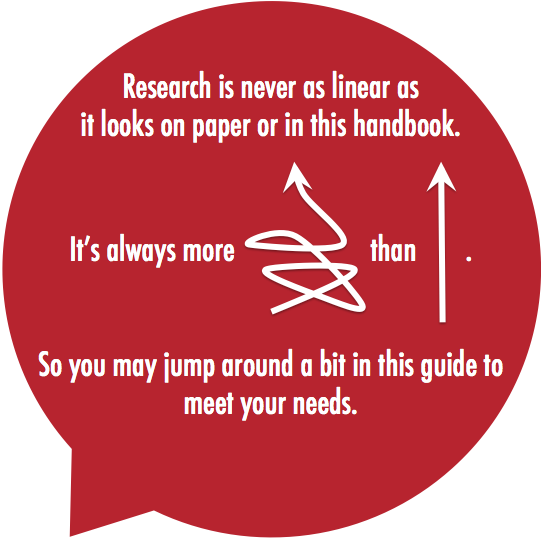
Moreover, research is something you learn by doing…and stumbling a few times. It’s an iterative process, or one that requires many tries to get right. There isn’t a shortcut for learning research, but if you follow along with the exercises in this book, you can break down a student research project and accomplish it piece by piece. No one just knows research. It’s something you pick up by doing it, reflecting on the experiences and results, redoing your work, and revising it in consultation with your professor and peers. Research involves exploration, risk taking, and a willingness to say, “Let’s see what we will find!”

Research is designed to suck the joy from my life
We’ve talked already about the arcane research terminology, so I won’t go into it again here. But students sometimes perceive research methods as boring. Practice knowledge and even theory are fun to learn because they are easy to apply and provide insights into the world around you. Research just seems like its own weirdly shaped and ill-fitting puzzle piece.
I completely understand where this perspective comes from and hope there are a few things you will take away from this course that aren’t boring to you. In the first section of this textbook, you will learn how to take any topic and learn what is known about it. It may seem trivial, but this is actually a superpower. Your social work education will teach you basic knowledge that can be applied to nearly all social work practice situations as well as some applied material applicable to specific social work practice situations. However, no education will provide you with everything you need to know. And certainly, no professor can tell you what will be discovered over the next few decades of your practice. Our work on literature reviews in the next few chapters will help you increase your skills and knowledge to become a strong social work student and practitioner. Following that, our exploration of research methods will help you understand how theories, practice models, and techniques you learn in other classes are created and tested scientifically. Like a colorful puzzle, you’ll see how all of the pieces fit together.
Get out of your own way
Together, these misconceptions and myths can create a self-fulfilling prophecy for students. If you believe research is boring, you won’t find it interesting. If you believe research is hard, you will struggle more with assignments. If you believe research is useless, you won’t see its utility. If you’re afraid that you will make mistakes, then you won’t want to try. While we certainly acknowledge that students aren’t going to love research as much as we do (we spent over a year writing this book, so we like it a lot!), we suggest reframing how you think about research using the following touchstones:
- All social workers rely on social science research to engage in competent practice.
- No one already knows research. It’s something I’ll learn through practice. And it’s challenging for everyone, not just me.
- Research is relevant to me because it allows me to figure out what is known about any topic I want to study.
- If the topic I choose to study is important to me, I will be more interested in exploring research to help me understand it further.
Students should be intentional about managing any anxiety coming from a research project. Here are some suggestions:
- Talk to your professor if you are feeling lost. We like students!
- Talk to a librarian if you are having trouble finding information about your topic.
- Seek support from your peers or mentors.
The structure of this textbook
The textbook is divided into five parts. In the first part (Chapters 1-4), we will review how to orient your research proposal to a specific question you want to answer and review the literature to see what we know about it. Student research projects come with special limitations, as you don’t have many resources, so our chapters are designed to help you think through those limitations and think of a project that is doable. In the second part (Chapters 5-8), we will bring in theory, causality, ethics to help you conceptualize your research project and what you hope to achieve. By the end of the second part, you will create a quantitative and qualitative research question. Parts 3 and 4 will walk you through how to conduct quantitative and qualitative research, respectively. These parts run through how to recruit people to participate in your study, what to ask them, and how to interpret the results of what they say. Finally, the last part of the textbook reviews how to connect research and practice. For some, that will mean completing program evaluations as part of agency-based practice. For others, it will mean consuming research as part of continuing education as a practitioner. We hope you enjoy reading this book as much as we enjoyed writing it!
If you are still figuring out how to navigate the book using your internet browser, consider watching our tutorial [LINK NEEDED]. Also, the exercises in each chapter offer you an opportunity to apply what you wrote to your own research project, so consider completing these as you read.
- Social workers engage in formal and informal research production as part of practice.
- If you feel anxious, bored, or overwhelmed by research, you are not alone!
- Becoming more familiar with research methods will help you become a better scholar and social work practitioner.
- With your peers, explore your feelings towards your research methods classes. Describe some themes that come up during your conversations. Identify which issues can be addressed by your professor and which can be addressed by students.
- Browse social work journals and identify an article of interest to you. Look up the author’s biography or curriculum vitae on their personal website or the website of their university.
- Cheung, J. C. S. (2016). Researching practice wisdom in social work. Journal of Social Intervention: Theory and Practice , 25 (3), 24-38. ↵
- For more on the CSWE accreditation standards see https://www.cswe.org/CSWE/media/AccredidationPDFs/2015-epas-and-glossary_1.pdf and the EPAS index in this book. ↵
- See: https://climate.nasa.gov/faq/17/do-scientists-agree-on-climate-change/ ↵
- See: http://www.igmchicago.org/surveys/import-duties ↵
- Godlee F. , Smith J. , & Marcovitch H . (2011) Wakefield’s article linking MMR vaccine and autism was fraudulent. British medical journal, 342 , 64-66. ↵
- Mahoney, A., Karatzias, T., & Hutton, P. (2019). A systematic review and meta-analysis of group treatments for adults with symptoms associated with complex post-traumatic stress disorder. Journal of affective disorders , 243 , 305-321. ↵
- American Psychiatric Association. (2017). Diagnostic and statistical manual of mental disorders (5th ed.) . Washington, DC ↵
- Barsky, A. (2015). DSM-5 and the ethics of diagnosis. New social worker . Retrieved from: https://www.socialworker.com/feature-articles/ethics-articles/dsm-5-and-ethics-of-diagnosis/ ↵
- Nogueira, B. L., Mari, J. D. J., & Razzouk, D. (2015). Culture-bound syndromes in Spanish speaking Latin America: the case of Nervios, Susto and Ataques de Nervios. Archives of Clinical Psychiatry (São Paulo), 42( 6), 171-178. ↵
- Eika, L., Mogstad, M., & Zafar, B. (2019). Educational assortative mating and household income inequality. Journal of Political Economy, 127 (6), 2795-2835. ↵
- Jenkins, P. J., & Kroll-Smith, S. (Eds.). (1996). Witnessing for sociology: Sociologists in court . Westport, CT: Praeger. ↵
- Wal-Mart Stores, Inc. v. Dukes , 564 U.S. (2011). The American Sociological Association (ASA) subsequently filed an amicus brief in support of what would be the class of individuals claiming gender discrimination. You can read the brief at http://asanet.org/images/press/docs/pdf/Amicus_Brief_Wal-Mart_v Dukes_et_al.pdf. For other recent amicus briefs filed by the ASA, see http://asanet.org/about/amicus_briefs.cfm . ↵
- Want to know more about the suit against Walmart or about Bielby’s analysis for the case? Check out the following source: Hart, M., & Secunda, P. M. (2009). A matter of context: Social framework evidence in employment discrimination class actions. Fordham Law Review , 78 , 37-70. (2009). A matter of context: Social framework evidence in employment discrimination class action. Fordham Law Review, 78 , 37–70. Retrieved from: http://www.fordhamlawreview.org/assets/pdfs/Vol_78/Hart_Secunda_October_2009.pdf ↵
- Drisko, J. W., & Grady, M. D. (2015). Evidence-based practice in social work: A contemporary perspective. Clinical Social Work Journal , 43 (3), 274-282. ↵
- McNeece, C. A., & Thyer, B. A. (2004). Evidence-based practice and social work. Journal of evidence-based social work , 1 (1), 7-25. ↵
- Substance Abuse and Mental Health Services Administration (2007). Pathways' housing first program . Retrieved from:https://www.samhsa.gov/homelessness-programs-resources/hpr-resources/housing-first-supports-recovery ↵
- DeCarlo, M. P., Schoppelrey, S., Crenshaw, C., Secret, M. C., & Stewart, M. (2020, January 1). Open educational resources and graduate social work students: Cost, outcomes, use, and perceptions. https://doi.org/10.31235/osf.io/k4ytd; Earley, M. A. (2014). A synthesis of the literature on research methods education. Teaching in Higher Education, 19 (3), 242-253. ↵
- Engel, R. J. & Schutt, R. K. (2016) The practice of research in social work (4th edition) . Washington, DC: Sage Publications ↵
examining the smallest levels of interaction, usually individuals
examining interaction between groups and within communities
examining social structures and institutions
a “gut feeling” about what to do based on previous experience
“learning by doing” that guides social work intervention and increases over time
predictable flaws in thinking
observing and analyzing information in a way that agrees with what you already think is true and excludes other alternatives
a way of knowing that attempts to systematically collect and categorize facts or truths
the science of humanity, social interactions, and social structures
claims about the world that appear scientific but are incompatible with the values and practices of science
information about the social world gathered and analyzed through scientific observation or experimentation
numerical data
data derived from analysis of texts. Usually, this is word data (like a conversation or journal entry) but can also include performances, pictures, and other means of expressing ideas.
the methods researchers use to examine empirical data
a single truth, observed without bias, that is universally applicable
one truth among many, bound within a social and cultural context
a process composed of "four equally weighted parts: 1) current client needs and situation, (2) the best relevant research evidence, (3) client values and preferences, and (4) the clinician’s expertise" (Drisko & Grady, 2015, p. 275)
a study that combines raw data from multiple quantitative studies and analyzes the pooled data using statistics
Graduate research methods in social work Copyright © 2020 by Matthew DeCarlo, Cory Cummings, Kate Agnelli is licensed under a Creative Commons Attribution-NonCommercial-ShareAlike 4.0 International License , except where otherwise noted.
Share This Book

- Reference Works
- Children, Youths, & Families
- Health & Mental Health
- Practice & Policy
- NASW Standards
- Children & Schools
- Health & Social Work
- Social Work
- Social Work Abstracts
Social Work Research
- Calls for Papers
- Faculty Center
- Librarian Center
- Student Center
- Booksellers
- Advertisers
- Copyrights & Permissions
- eBook Support
- Write for Us
- Graduation Sale
NASW members can access articles online at: Social Work Research
Social Work Research publishes exemplary research to advance the development of knowledge and inform social work practice. Widely regarded as the outstanding journal in the field, it includes analytic reviews of research, theoretical articles pertaining to social work research, evaluation studies, and diverse research studies that contribute to knowledge about social work issues and problems.
Ohio State nav bar
The Ohio State University
- BuckeyeLink
- Find People
- Search Ohio State
So why is research important to social work?

As social workers, we train to be able to see the multitude of invisible lines within the systems that hold our lives together, or divide us. We learn to recognize the disconnects, and to help our clients figure out how to reconnect the dots. We view the world through a lens of person-in-environment, that is to say, we seek to understand the context in which our clients live.
The social sciences have an inherent obligation not only to keep abreast of current relevant research, but also to be competent enough to apply new treatments and insights within their practice. Social workers are truly dedicated professionals who have to complete a minimum number of continuing education credits to continue practicing. We don’t get to pick and choose the individuals we help, which is why we have to constantly develop our cultural competencies to identify the strengths of those we are helping. So, research is important to social work because it helps us be effective!
According to the NASW, research in social work helps us:
- Assess the needs and resources of people in their environments
- Evaluate the effectiveness of social work services in meeting peoples needs
- Demonstrate relative costs and benefits of social work services
- Advance professional education in light of changing contexts for practice
- Understand the impact of legislation and social policy on the clients and communities we serve (Retrieved from http://www.socialworkpolicy.org/research)

I still do not know what my research question will be for my senior thesis, but I am beginning to pare down some topics that interest me such as:
- Effects of childhood trauma
- The school-to-prison pipeline
- Trauma-informed therapies within prisons
- Effectiveness of prison diversion programs
8 thoughts on “ So why is research important to social work? ”
try explaining in detail
article quite informing for an amateur in research
In doing any of interventions;evidence based is needed. Not intuition,you need to do assessment of the problem before intervention.Then again you need to to evaluation on the service you provided if has positive impact to your client.
It is a very informative piece of work
try explaining in detail the points listed as to where the nexus between Research and Social work lie
are there means to conduct dual research projects with your institutions?
Akulu muziika zithu zonse ap tisamachiteso kuvutika iyayi 😏😏
CCleaner (Crap Cleaner) yasir252 is a freeware system optimization, privacy, and cleaning tool. It removes unused files from your system allowing Windows
Leave a Reply Cancel reply
Your email address will not be published. Required fields are marked *
Save my name, email, and website in this browser for the next time I comment.
How to become a research social worker
- How to become a research sw
- What is a research social worker
- What do research social worker do
- Salary and outlook
When people think about social work, research social work is probably not one of the first fields that comes to mind. Nevertheless, research social work actually plays an important role as its findings can dictate not only governmental policy, but also political reform as well as the allocation of funding.
Research social workers need to be methodical, objective, and thorough in their research. As with any other field of research, the goal is not to confirm what you hope to be true, but rather figure out what is true.
For example, suppose that a city program offers a $1 million grant to a local community led organization. Before that money can be spent, the grant stipulates that a study must be completed to find out what groups in the community need the most support.
In this case, although the research social worker might have pre-existing ideas about how the money should be spent, it is their job to put their personal beliefs aside and complete an objective study of the community to determine where resources are lacking.
The preceding example illustrates a case where a research social worker may be polling hundreds of thousands or people, looking at economic and housing data, and otherwise compiling a macro-view of the community. Research social work can also exist at the micro-level.
Individual research
Participatory research refers to research whereby a social worker integrates themselves with a person or family in order to understand the problems they face and, more broadly, what community resources are missing or inadequate. There are both advantages and disadvantages to this “micro-view” participatory research.
Advantages
- It’s possible to gain a very detailed view of a single person’s life and how they interact with the community. Much can be learned that would not otherwise reveal itself through a high level poll or questionnaire.
- Due to the trust that can form between a community member and a research social worker, the “subject” may reveal more than they would with a questionnaire.
Disadvantages
- Participatory research is time consuming and resource heavy. For example, if a research social worker spends two days with a family, that’s time that they could have otherwise spent gathering data from hundreds or thousands of community members via more efficient means.
- It can become very difficult to remain objective as participatory research can lead the researcher to believe that one family’s problems are the most pressing, even if data strongly indicates that other groups are in greater need.
- Relationships can form between the social worker and the subject. While these are not necessarily negative, they may lead to biases in data collection which wouldn’t otherwise be prevalent with more impersonal research methods.
Ultimately both macro and micro (participatory) research have a role to play in data gathering. Throughout their careers a research social worker will most likely conduct both kinds of research, and everything in between.
How research social workers need to conduct themselves
In terms of participatory research it is important for a research social worker to take into account multiple voices from the community. So even if a research social believes they know which groups are most at risk they still need to conduct wide ranging interviews and remain objectively open to the answers that they receive. This really touches upon a key facet of research social work: objectivity. Being open to what the data is saying regardless of whether it confirms or denies existing views held by the research social worker.
Also, it’s important to realize that research social workers may not be able to divulge the purpose of their research as they’re carrying it out. If participants knew the reason that the social worker was conducting a study they may be biased in how they present themselves or answer the social worker’s inquiries. This can actually prove frustrating for research social workers as they may not be able to answer even the most basic questions about what they’re doing.
Why social work research is important
We’ve covered why social research is important in regard to determining needs within a community and how that research can help to allocate funding to the proper areas. But research social work is also important in determining the efficacy of programs that have been implemented in the community. For example, research social workers can,
- Administer before and after surveys to determine how the implementation of a new program has benefitted (or not benefitted) the community.
- They may also conduct individual interviews with community members to find out how they feel about new programs. More specifically, these interviews may also be a chance to learn exactly how community members are benefitting from a program and also their thoughts on how it can be improved.
Research social work is very important in that it helps to determine what programs are needed in a community and after the programs are created it is research social workers who measure their efficacy.
While a “regular” social worker may spend their life seeing the trees (dealing with individual cases) it is the research social worker’s goal to see the forest. That is, understand the broader macro environment and the role that community programs play in it.
Educational requirements to become a research social worker
Most candidates should only consider taking a degree from a CSWE ( Council on Social Work Education ) accredited institution. Educational institutions without this accreditation may lack a rigorous teaching approach and degree holders from non-CSWE universities may find it more difficult to locate a good job.
Research social work typically requires a candidate to have a Ph.D. as they will be expected to have a comprehensive understanding of statistics and how to compile the data that they collect. Thus research social work typically requires a large commitment in terms of schooling.
In some cases, however, a social worker with a masters degree may be able to find work in the research field. Typically this person will handle assignments like distributing questionnaires and doing other data collection tasks in the neighborhood. A Ph.D. social worker will then compile that data and present the findings to local and federal government officials, among others.
Why research social work can be difficult
One of the primary difficulties associated with social work research is that the social research worker’s role isn’t actually to help, but rather to study and gather data. This is not to suggest that the social worker must be robotic and ignore all problems, however, their role isn’t to solve but to observe. A research social worker may suggest that a “regular” social worker get involved but that’s typically the extent of what they can do.
It can also be difficult doing participatory research, getting to know a subject or a family over the course of a day or two and then having to leave that family and move on. A normal social worker may stay with a family for months or even years, and enjoy a greater reward as that family’s situation improves.
Thus social work research is suggested for those who understand their limited intervention role and are truly interested in data and devising the most effective ways to measure the efficacy of programs within the neighborhood. Research social workers can get their satisfaction from seeing community programs succeed, rather than working with individual subjects.
Research social work career outlook
It can be difficult to determine the career outlook specifically in regard to the research social worker. This is a very niche area of social work, all the more so since it typically requires a Ph.D. That being said, we can still gain valuable information by looking at overall trends for the social work field.
The BLS (Bureau of Labor Statistics) estimates that from 2021 to 2031 there will be a 9 percent growth rate in the field of social work. In terms of actual numbers, 64,000 new social work jobs will be created by 2031.
Research social worker salary
Again, when it comes to determining the salary for a research social worker it’s difficult as there is little data available. That being the case we can still make a fairly good estimation of how much research social workers earn.
According to HumanServicesEdu.org , “NASW found that a DSW or PhD can boost your earnings by around $17,000 over the baseline numbers you could expect with a bachelor’s.”
Overall we can see that research social workers tend to earn more than other social workers and their job prospects are very good.
Frequently asked questions
A research social worker conducts research studies and evaluations to gather data and evidence related to social work practice and policies.
They use a range of research methods, such as surveys, interviews, focus groups, observation, or experimental designs, to answer research questions and test hypotheses.
A Bachelor’s degree in social work is the minimum requirement for most entry-level social work positions. However, many research social work positions require a Master’s degree in social work. Gain relevant work experience and develop research skills. You can also pursue a DSW or PhD to further your knowledge and expertise.
Research social workers need to be knowledgeable about different research methods, social policies, be able to analyze and interpret complex data.

Want to create or adapt books like this? Learn more about how Pressbooks supports open publishing practices.
11.3 Action research
Learning objectives.
- Define and provide at least one example of action research
- Describe the role of stakeholders in action research
Action research is defined as research that is conducted for the purpose of creating social change. When conducting action research, scholars collaborate with community stakeholders at all stages of the research process with the aim of producing results that will be usable in the community and by scientists. Stakeholders are individuals or groups who have an interest in the outcome of your study. Social workers who engage in action research never just go it alone; instead, they collaborate with the people who are affected by the research at each stage in the process. In action research, stakeholders, particularly those with the least power, are consulted on the purpose of the research project, research questions, design, and reporting of results.

Action research also distinguishes itself from other research in that its purpose is to create change on an individual and community level. Kristin Esterberg (2002) puts it quite eloquently when she says, “At heart, all action researchers are concerned that research not simply contribute to knowledge but also lead to positive changes in people’s lives” (p. 137). As you might imagine, action research is consistent with the assumptions of the critical paradigm, which focuses on liberating people from oppressive structures. Action research has multiple origins across the globe, including Kurt Lewin’s psychological experiments in the United States and Paulo Friere’s literacy and education programs (Adelman, 1993; Reason, 1994). Over the years, action research has become increasingly popular among scholars who wish for their work to have tangible outcomes that benefit the groups they study.
Action research does not bring any new methodological tricks or terms, but it uses the processes of science in a different way from traditional research. What topics are important to study in a neighborhood or with a target population? A traditional scientist might look at the literature or use their practice wisdom to formulate a research question. An action researcher, on the other hand, would consult with the target population itself to see what they thought were the most pressing issues and best solutions. In this way, action research flips traditional research on its head. Scientists are more like consultants who provide the tools and resources necessary for a target population to achieve their goals and address social problems.
According to Healy (2001), the assumptions of participatory-action research are that (a) oppression is caused by macro-level structures such as patriarchy and capitalism; (b) research should expose and confront the powerful; (c) researcher and participant relationships should be equal, with equitable distribution of research tasks and roles; and (d) research should result in consciousness-raising and collective action. Coherent with social work values, action research supports the self-determination of oppressed groups and privileges their voice and understanding through the conceptualization, design, data collection, data analysis, and dissemination processes of research.
There are many excellent examples of action research. Some of them focus solely on arriving at useful outcomes for the communities upon which and with whom research is conducted. Other action research projects result in some new knowledge that has a practical application and purpose in addition to the creation of knowledge for basic scientific purposes.
One example of action research can be seen in Fred Piercy and colleagues’ (Piercy, Franz, Donaldson, & Richard, 2011) work with farmers in Virginia, Tennessee, and Louisiana. Together with farmers in these states, the researchers conducted focus groups to understand how farmers learn new information about farming. Ultimately, the aim of this study was to “develop more meaningful ways to communicate information to farmers about sustainable agriculture” (p. 820). This improved communication, the researchers and farmers believed, would benefit not just researchers interested in the topic but also farmers and their communities. Farmers and researchers were both involved in all aspects of the research, from designing the project and determining focus group questions to conducting the focus groups and finally to analyzing data and disseminating findings.
Perhaps one of the most unique and rewarding aspects of action research is that it is often interdisciplinary. Action research projects might bring together researchers from any number of disciplines, from the social sciences, such as sociology, political science, and psychology; to an assortment of physical and natural sciences, such as biology and chemistry; to engineering, philosophy, and history (to name just a few).
Anyone interested in social change can benefit from having some understanding of social scientific research methods. The knowledge you’ve gained from your methods course can be put to good use even if you don’t have an interest in pursuing a career in research. As a member of a community, perhaps you will find that the opportunity to engage in action research presents itself to you one day. Your background in research methodology will no doubt assist you in making life better for yourself and those who share your interests, circumstances, or geographic region.
Spotlight on UTA School of Social Work
Dr. maxine davis shares experiences with action research.
There are various types of action research. Although the degree to which stakeholders are involved may vary across different stages of the research and dissemination process, each type is valuable and aims to accomplish shared decision-making, responsibility, and power between the researcher and the researched. I will share with you a few examples of recent research that I have had the pleasure of being involved in.
Case 1 (St. Louis, MO) Community based participatory research (CBPR)

As a community organizer, activist, and Missionary, Ms. Johnson is well connected to her community in North St. Louis city. She has worked in partnership with a number of clergy members throughout St. Louis on improving the overall well-being of African-Americans for a number of years. From education to political engagement, she has her pulse on the many issues of local residents and a wide network of clergy and ministers who trust her. In 2014, I partnered with Ms. Johnson to explore clergy perceptions on religious or spiritual (R/S) related abuse within intimate partner violence (IPV). Ms. Johnson conducted more than half of the interviews (many of which occurred only because of the trust clergy members had with her, not due to my recruitment efforts). We coded the data independently and analyzed it as a team. As a result, Ms. Johnson gained the skills to conduct basic qualitative data analysis that may be applicable to her other work. The study results revealed that R/S abuse in IPV was a serious issue that Black clergy often faced in ministry. Furthermore, they desired training to help them to better prepare in responding to this problem. The project did not end at manuscript development, rather the efforts to address this issue continue as we develop and plan to implement R/S specific IPV training for Black clergy in St. Louis.
Case 2 (Chicago, IL) Community-engaged research using a Community Collaborative/Advisory Board (CCB)

A colleague who knew of my interest in the intersection of religious faith and IPV connected me with a priest at St. Pius V parish who was looking for someone to evaluate a portion of the church’s domestic violence program. The project combined evaluation research and action research. I sought and obtained funding tosupport the first step of a multi-phase project involving process evaluation in preparation for a longitudinal impact (i.e. outcome) evaluation. I convened a collaborative board of relevant stakeholders from different organizations and relocated to Chicago (Pilsen neighborhood) to embark upon the research. Over the course of one year, I lived in the community and collected various types of data from a variety of sources while the CCB and I developed an evaluation plan that would meet the organization’s needs. The primary research questions explored were: “What is The Men’s Group (TMG)?” and “Why do participants attend and remain engaged in TMG?” We discovered that TMG was a trauma-informed, culturally-tailored (to Latino men), spirituality and group based partner abuse intervention program (PAIP) aiming to stop violence perpetration and help participants become self-aware. Men remained engaged in the PAIP because they were met with respect by staff/facilitators, reported gaining benefits because of participation, and connected with other group members through a brotherhood. A quasi-experimental design using quantitative data is currently underway.
Case 3 (Grand Prairie, TX) Youth-led CBPR

The Grand Prairie Storm Track & Field Association (GP Storm) reached out to me after their founders saw me present on the potential of hip-hop music influencing public perceptions about IPV. Our shared interest on increasing Black/African-American representation in health-related research careers brought us together. I invited high school students who were affiliated with the program to join me in examining this area, but also encouraged them to develop a set of their own research questions that they were excited to explore. We met weekly over the course of 3 months in the summer of 2019 and analyzed the lyrics of 7 hip-hop songs. The youth-led research team consisted of six Black/Multiracial young women (5 high school; 1 middle school), the organization founder/director, a PhD student, and myself. The findings revealed that hip-hop music brings awareness to IPV/A by discussing Death, Denial, Freedom, and Physical violence/various types of consequences. Partnering with the GP Storm and affiliated students (the community researchers) allowed the research team to examine research questions that were of interest to a wider audience and do so by drawing on multiple perspectives, thereby improving the rigor of the study. The research did not end here; rather next steps involve hosting a listening party as an intervention to reduce violence and acceptability thereof amongst youth and adults.
Lessons learned
I have learned a few lessons through conducting community-engaged research that I think are worth sharing. It is imperative that you are comfortable openly discussing race and diversity if you plan on engaging in action research with communities of color. This applies, regardless of your own identity, but is especially relevant for those who are an “outsider” in terms of gender or race/ethnicity. The second lesson is that trust need not be earned once, rather you must continuously build and maintain trust in order to conduct sound research. You must also plan to nurture and intend to maintain these relationships in a humanistic manner, beyond that of “a research product.” If your intentions are genuine and you are honest with any trepidations, that plus meaningful project delivery will carry you far.
Refer to following articles for more exploration into this research:
Davis, M., ^Johnson, M., Bowland, S. (In Draft) “I hate it…but it’s real”: Black Clergy Perspectives on Intimate Partner Violence related Religious/Spiritual Abuse
Davis, M., ^Dahm, C., Jonson-Reid, M., Stoops, C., Sabri, B. (Revisions Submitted-Awaiting Final Decision). “The Men’s Group” at St. Pius V: A Case Study of a Parish-Based Voluntary Partner Abuse Intervention Program.
^denotes community partners
Key Takeaways
- Action research is conducted by researchers who wish to create some form of social change.
- Stakeholders are true collaborators in action research.
- Action research is often conducted by teams of interdisciplinary researchers.
- Action research- research that is conducted for the purpose of creating some form of social change in collaboration with stakeholders
- Stakeholders – individuals or groups who have an interest in the outcome of your study
Image attributions
protest by BruceEmmerling CC-0
Maxine Johnson and Maxine Davis by Maxine Davis CC BY-NC-ND
Community Researchers in Partnership by Maxine Davis CC BY-NC-ND
GP Storm by Maxine Davis CC BY-NC-ND
Foundations of Social Work Research Copyright © 2020 by Rebecca L. Mauldin is licensed under a Creative Commons Attribution-NonCommercial-ShareAlike 4.0 International License , except where otherwise noted.
Share This Book
School of Social Work
2024 PSU Research Award Winners Announced
Annual Awards acknowledge exceptional research, scholarship, creativity, and commitment to student success
by Molly Baer Kramer April 22nd 2024 Share

Today, Portland State University announced its 2024 awards for excellence in research, mentoring, and research administration . PSU’s Research Awards acknowledge faculty who exhibit exceptional research, scholarship, creativity, and commitment to the success of PSU students, and recognize one research administrator who makes an outstanding contribution to the production of research at the university.
Six of the 15 research awards are university-wide; individual colleges and schools award the remaining nine.
"I am thrilled to celebrate this year's award recipients at Portland State University,” said Rick Tankersley, Vice-President for Research & Graduate Studies, whose office manages the awards process. “These awards showcase the diverse and impactful contributions of our faculty and staff across various disciplines. Each winner enhances our mission through outstanding research and mentorship, enriching both PSU and our student community. It's especially exciting to introduce the 'Undergraduate Research Mentor of the Year' award for the first time this year, highlighting our commitment to excellence and innovation in undergraduate education."
This year’s awardees will be celebrated at a special reception on Friday, May 10, to conclude the university's Research Week .
The university research award winners are:
- Presidential Career Research Award: Birol Yeşilada , Professor in Political Science and International Studies and Director, Center for Turkish Studies and the Mark O. Hatfield Cybersecurity & Cyber Defense Policy Center
- Early Career Research Award: Fang Song , Associate Professor in Computer Science
- Research Faculty Award: Papireddy Kancharla , Research Assistant Professor in Chemistry
- Graduate Mentoring Excellence Award: Karen Haley , Professor in the Postsecondary, Adult, and Continuing Education (PACE) program
- Undergraduate Research Mentor of the Year: Bill Griesar , Teaching Assistant Professor in Psychology
- Research Administrator of the Year: Becca Lockwood , Sponsored Projects Officer
The college/school research award winners are:
- College of Liberal Arts and Sciences Researcher of the Year: Alida Cantor , Associate Professor, Geography
- College of Education Researcher of the Year: Rana Yaghmaian , Associate Professor and Department Chair of Counselor Education
- College of the Arts Researcher of the Year: Alison Heryer , Costume Designer, School of Art + Design
- College of Urban and Public Affairs Researcher of the Year: Lindsay Benstead , Professor, Department of Politics and Global Affairs
- Maseeh College of Engineering and Computer Science Researcher of the Year: Raúl Bayoán Cal , Professor, Mechanical & Materials Engineering
- OHSU-PSU School of Public Health Researcher of the Year: Neal Wallace , Professor, Health Management & Policy, Health Systems & Policy
- School of Business Researcher of the Year: Marta Stelmaszak Rosa , Assistant Professor of Information Systems
- School of Social Work Researcher of the Year: Matthew Town , Assistant Professor, Social Work
- University Honors College Researcher of the Year: Amy Borden , Associate Professor, Humanities and Film Studies
Recipients of the awards are faculty and staff members at PSU who have shown extraordinary dedication to their work, going above and beyond to make progress in their fields and inspire the next generation. They are nominated by their colleagues and then selected by a jury of their peers, based on the significance and quality of their academic or creative work and their strong commitment to creating an environment that supports student success and research excellence. "This year, we are particularly proud of the contributions of our research administrators, whose efforts are crucial in facilitating our pioneering research endeavors," Tankersley stated.
"I am delighted to honor the remarkable achievements of our award winners, whose work spans multiple disciplines at Portland State University,” said Tankersley. “These accolades reflect our faculty and staff's significant impact on our academic community and their fields. Their dedication to research excellence and student success not only advances PSU's mission but also inspires within and beyond the university."
Related Links:
- View bios of the 2024 Research Award recipients here
Zambia visit shows SSW’s global impact
A UNC School of Social Work delegation saw how their research helped a nonprofit create jobs in rural areas.
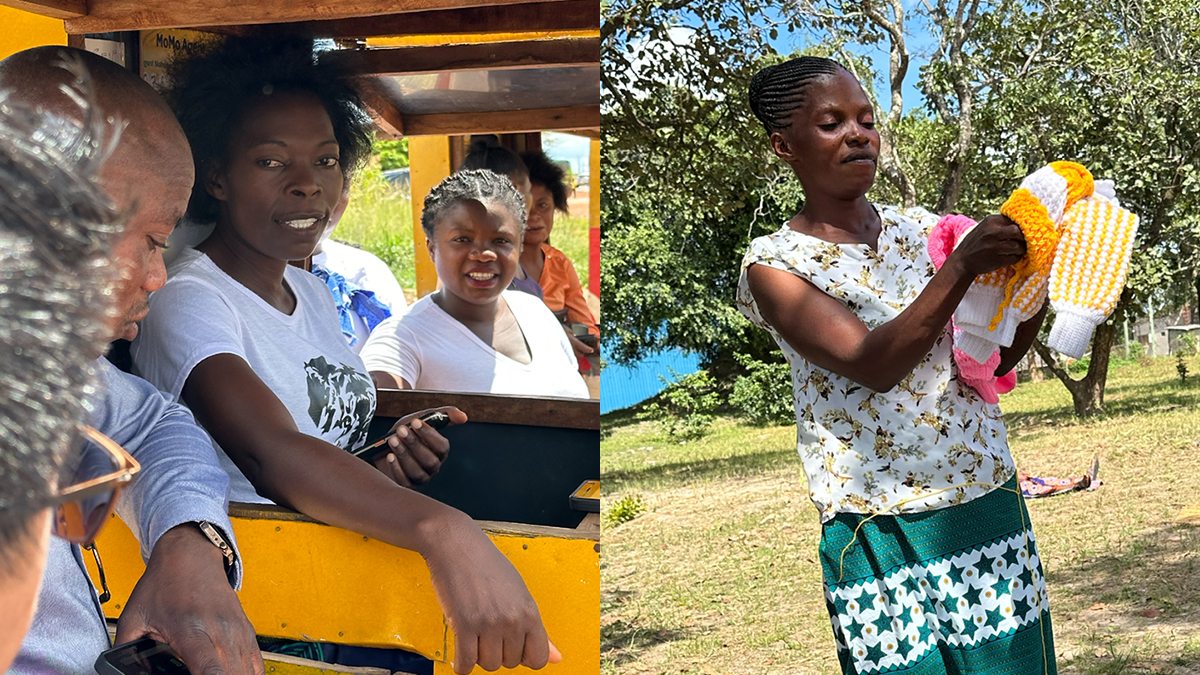
A small delegation from the UNC School of Social Work visited the growing rural town of Solwezi (population 90,000) in the North-Western Province of Zambia in March. They came to learn about the impact of local women’s savings and credit groups and their financial literacy training.
The trip was coordinated by Gina Chowa and Rain Masa from the school’s center for Global Social Development Innovations in partnership with longtime collaborator Mathias Zimba, executive director of Rising Fountains Development Program in Zambia.
“As partners, we work together to identify ideas and practices that will change lives for the better,” Masa said. “Researchers and graduate students at the school can help build the evidence needed to demonstrate to policymakers, officials and the business community what is needed to improve the lives of rural Zambians .”
Improving lives in six countries
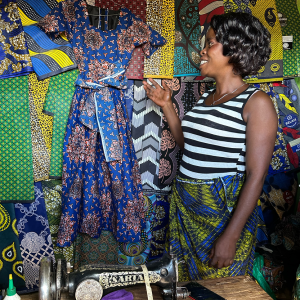
Masa is an associate professor who also serves as GSDI’s research director. He has worked collaboratively on both economic security and HIV treatment projects with Rising Fountains, a Zambian nonprofit dedicated to improving the livelihoods of women and children in rural areas.
Masa emphasized how community involvement localizes these economic programs and increases their chance of success and relevance.
“Economic security is the focal point of our work,” said Masa. “We provide funding and, maybe more importantly, we are available to Mathias and his team for ongoing capacity support as well.”
Paving career paths
During the visit to her native Zambia, Chowa was visibly moved at the end of a day spent at a teen center and a church. The delegation heard from over a dozen enthusiastic groups of about 20 women each and the men who had joined in support of them.
“These people. This is why I do the work I do,” Chowa said.
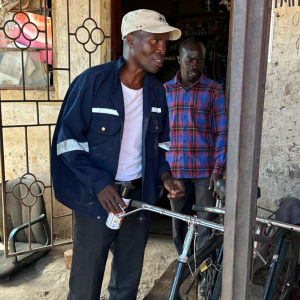
Following the presentations, the delegation went to see the small business owners in action. These included a man who bought spare parts for just one bicycle and now runs a repair shop with several assistants, craftswomen who purchased a sewing machine and yarn to create and sell clothing, and a woman who uses a mobile phone and SIM cards to help townspeople make financial transactions.
“This is not about politics,” said one Solwezi community leader. “I stand in the middle in support of our people helping better their lives and those of their families.”
At the end of the visit, local residents piled baskets full of sweet melons, gourds and pineapples at the front of a small church as parting gifts.
“The bounty and generosity of spirit of the nearly 150 people of Solwezi whom we visited with earlier this month made a lasting impression,” said Alice Washington, a longtime member of the school’s advisory board.
Read more about the Zambia trip and support the UNC School of Social Work’s global partnerships by making a gift to the Global Social Development Innovations Fund .
See climate’s impact on algae to zoos in Carolina Digital Repository’s curation of open access articles.

Robert Hawkins named new SSW vice dean
An associate dean at NC State, he will take on his role at the UNC School of Social Work on July 1.

A message from the interim chancellor: Celebrating our students
In a campus email, Lee H. Roberts wrote it's a privilege to interact with students and inspiring to learn about the diverse range of interests they're working on.
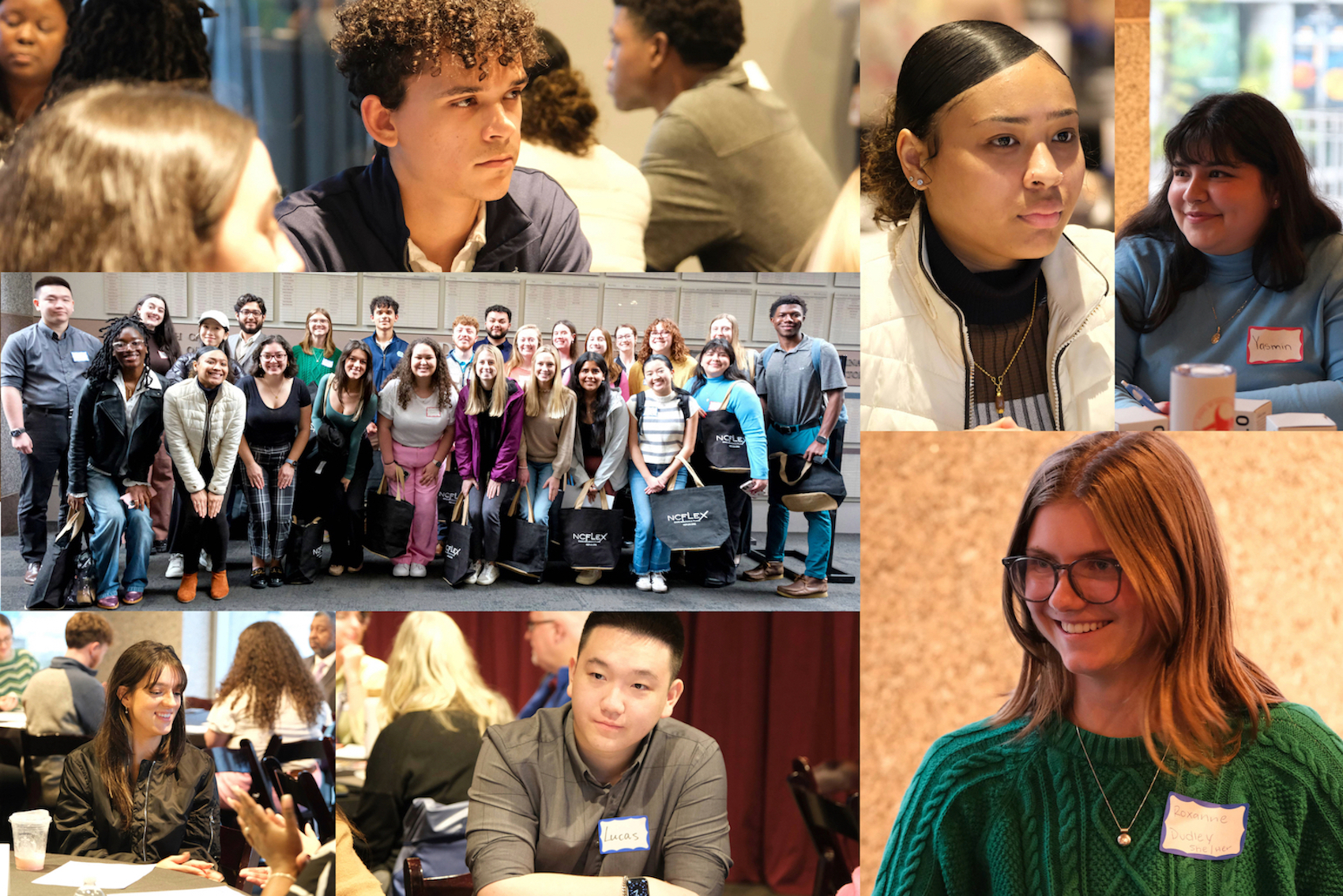
Career Treks event highlights public professions
School of Education students networked in Raleigh with representatives from 11 state agencies.

Global studies scholar aspires to diplomacy
After earning a master’s degree, Kat Goodpaster became assistant director of Carolina’s Russian Flagship Program.
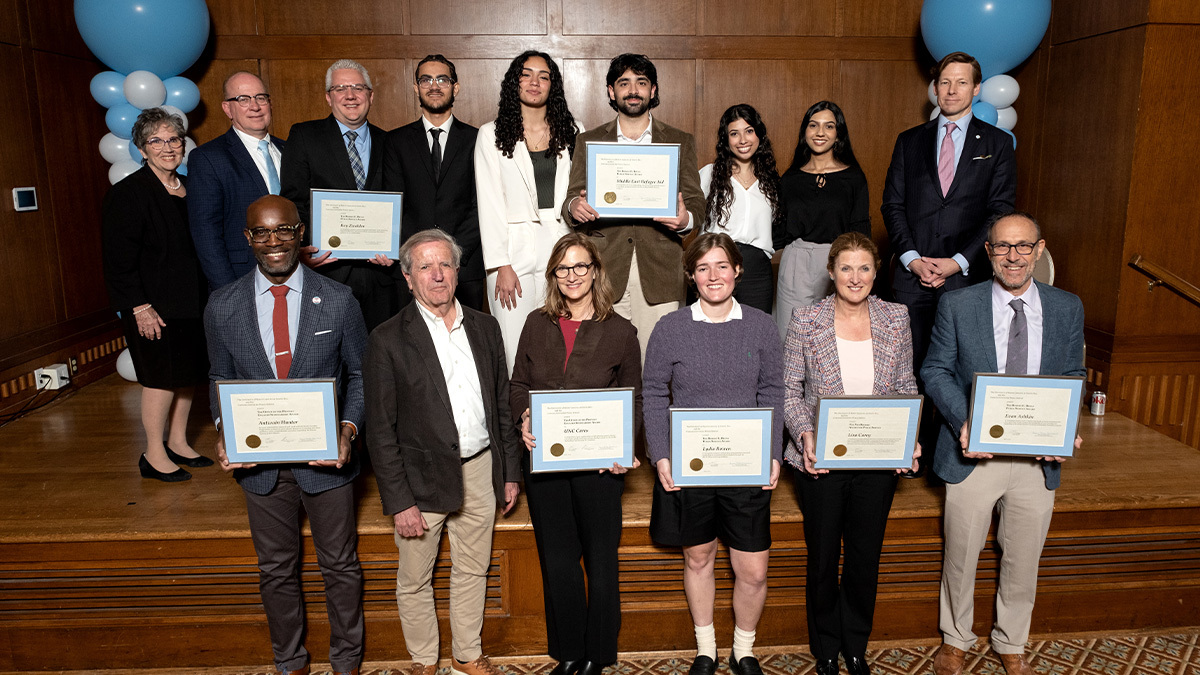
Public Service Awards go to 7 people, 2 groups
The Carolina Center for Public Service honored work on health disparities, refugee aid and more.

CHASE Solar Hub pioneers liquid fuel conversion
At the center's Chapel Hill headquarters, more than 100 researchers work to turn sunlight into methanol.

Trash Force picks up after campus
What started as an extra credit opportunity grew into a club who has fun keeping Carolina clean.
Share on Mastodon
- Subject List
- Take a Tour
- For Authors
- Subscriber Services
- Publications
- African American Studies
- African Studies
- American Literature
- Anthropology
- Architecture Planning and Preservation
- Art History
- Atlantic History
- Biblical Studies
- British and Irish Literature
- Childhood Studies
- Chinese Studies
- Cinema and Media Studies
- Communication
- Criminology
- Environmental Science
- Evolutionary Biology
- International Law
- International Relations
- Islamic Studies
- Jewish Studies
- Latin American Studies
- Latino Studies
- Linguistics
- Literary and Critical Theory
- Medieval Studies
- Military History
- Political Science
- Public Health
- Renaissance and Reformation
Social Work
- Urban Studies
- Victorian Literature
- Browse All Subjects
How to Subscribe
- Free Trials
In This Article Expand or collapse the "in this article" section Survey Research
Introduction.
- Cross-Cultural Research
- Self-Administered Paper/Pencil
- Interviewer-Administered Paper/Pencil
- Computer-Assisted
- Online or Electronic
Related Articles Expand or collapse the "related articles" section about
About related articles close popup.
Lorem Ipsum Sit Dolor Amet
Vestibulum ante ipsum primis in faucibus orci luctus et ultrices posuere cubilia Curae; Aliquam ligula odio, euismod ut aliquam et, vestibulum nec risus. Nulla viverra, arcu et iaculis consequat, justo diam ornare tellus, semper ultrices tellus nunc eu tellus.
- Assessing the Mental Health Needs of Older People
- Community-Needs Assessment
- Cultural Competence and Ethnic Sensitive Practice
- Evidence-based Social Work Practice
- Evidence-based Social Work Practice: Finding Evidence
- Experimental and Quasi-Experimental Designs
- Impact of Emerging Technology in Social Work Practice
- Interviewing
- Measurement, Scales, and Indices
- Psychometrics
- Qualitative Research
- Research Ethics
- Social Intervention Research
- Social Work Research Methods
Other Subject Areas
Forthcoming articles expand or collapse the "forthcoming articles" section.
- Child Welfare Effectiveness
- Rare and Orphan Diseases and Social Work Practice
- Unaccompanied Immigrant and Refugee Children
- Find more forthcoming articles...
- Export Citations
- Share This Facebook LinkedIn Twitter
Survey Research by Jorge Delva , Debora S. Tauiliili LAST REVIEWED: 30 July 2014 LAST MODIFIED: 30 July 2014 DOI: 10.1093/obo/9780195389678-0182
In its simplest term, a survey refers to the administration of questions to obtain information about people’s behaviors, attitudes, and beliefs about a topic. A survey may include a single question by asking, for example, if respondents approve of child spanking, or if they ever smoked cigarettes; or a survey may consist of a battery (a compilation) of questions to assess, measure, or determine, for example, whether the respondent has ever experienced depressive symptoms. When more than one question is asked, the set of questions is often referred to as an instrument or questionnaire. Questionnaires may include stand-alone questions and multiple questions about the same topic and constructs. Examples of stand-alone questions include asking someone to disclose his or her age or to describe his or her attitude toward abortion. Questionnaires may also include a measure, (a set of related questions that, when combined, may better assess the intended construct). Thousands of measures exist, and most can be found on the Internet. A survey can be administered once or repeatedly, to a handful of individuals or to hundreds of thousands, and it can be administered by mail, in person, by phone, email, Internet, or through mobile devices. A considerable amount of survey research in social work, and in several social science disciplines and allied fields (e.g., education and public health) is devoted to measuring a construct with a high degree of validity and reliability. Validity refers to ensuring that the question(s) do measure the construct they are purported to measure, and reliability refers to measuring the construct consistently. The authors’ experience is that most education about survey research in social work and the social sciences and allied disciplines focuses on measurement issues; there is less concern with best practices to draw samples that are representative of the larger population. The analytic methods that are needed to properly analyze these data also tend to be neglected. To address these gaps, in this annotated bibliography we review books, manuscripts, reports, and Internet sites on the administration and analyses of surveys that rely on samples drawn to be generalizable to the larger population. From time to time, we also provide examples of surveys conducted with samples that were not drawn to be representative of the larger populations to illustrate some aspect of survey research, data collection, or analytic methods, with some of the most nascent approaches such as those studies using real-time data capture and social media.
Healey 2002 , Henry 1990 , Kalton 1983 , and Rubin and Babbie 2014 provide excellent introductions to the various survey sampling and survey (or questionnaire) administration methods that survey researchers can use without relying on advanced statistical terms. Stone, et al. 2007 and Thyer 2010 include chapters on various sampling methods, but Lavrakas 2008 provides the most comprehensive coverage of survey methods and analytic approaches.
Healey, J. F. 2002. Statistics: A tool for social research . 2d ed. Belmont, CA: Wadsworth/Thomson Learning.
This book has a chapter that provides a clear introductory description of the concepts of sampling and sampling distribution for those interested in conducting survey research by drawing samples that can be representative of the general population.
Henry, G. T. 1990. Practical sampling . Newbury Park, CA: SAGE.
This book provides an easy-to-read description of various sampling strategies that can help the survey researcher draw representative samples, leading to the most precise estimate. It includes numerous examples of various sampling strategies. This book does not require advanced knowledge of statistics for the reader to get a general overview of representative samples.
Kalton, G. 1983. Introduction to survey sampling . Newbury, CA: SAGE.
This book also provides an easy-to-read description of various sampling strategies (proportionate and disproportionate stratification, cluster and multistage sampling, probability proportional to size sampling, sampling frames) as well as a description of nonresponse, sample size calculations, and survey analysis. This book will be of interest to those who desire to have a general knowledge of the ways survey research may be conducted with sampling methods that can generalize the findings of the survey to the larger population.
Lavrakas, P. J. ed. 2008. Encyclopedia of survey research methods . Thousand Oaks, CA: SAGE.
This encyclopedia, over one thousand pages with over 320 contributors, provides what is perhaps the most comprehensive and detailed coverage of survey research methods, covering a considerably wide range of methodological and statistical topics. Available online by subscription.
Rubin, A., and E. R. Babbie. 2014. Research methods for social work . Belmont, CA: Brooks/Cole.
This book includes chapters, with an excellent introduction to sampling methods with easy-to-follow examples. A chapter called “Survey Research” essentially refers to survey (or questionnaire) administration methods (interviews, self-administered Internet, telephone).
Stone, A. A., S. Shiffman, A. A. Atienza, and L. Nebeling, eds. 2007. The science of real-time data capture . New York: Oxford Univ. Press.
This edited book provides a comprehensive discussion and review of real-time data capture methods, focusing on one that is called ecological momentary assessment (EMA). This is an excellent book for anyone interested in detailed methodological and some statistical considerations of EMA.
Thyer, B. 2010. The handbook of social work research methods . 2d ed. Thousand Oaks, CA: SAGE.
This edited book includes a chapter, “Probability and Sampling” (pp. 37–50), that provides a clear description of the concept of probability and different types of sampling procedures (random, stratified, systematic), with easy-to-understand examples. Those with introductory knowledge of statistics will be able to more easily understand the basic statistical concepts that are included as part of the examples. However, those without statistical knowledge will still be able to gain an understanding of different sampling procedures.
back to top
Users without a subscription are not able to see the full content on this page. Please subscribe or login .
Oxford Bibliographies Online is available by subscription and perpetual access to institutions. For more information or to contact an Oxford Sales Representative click here .
- About Social Work »
- Meet the Editorial Board »
- Adolescent Depression
- Adolescent Pregnancy
- Adolescents
- Adoption Home Study Assessments
- Adult Protective Services in the United States
- African Americans
- Aging out of foster care
- Aging, Physical Health and
- Alcohol and Drug Abuse Problems
- Alcohol and Drug Problems, Prevention of Adolescent and Yo...
- Alcohol Problems: Practice Interventions
- Alcohol Use Disorder
- Alzheimer's Disease and Other Dementias
- Anti-Oppressive Practice
- Asian Americans
- Asian-American Youth
- Autism Spectrum Disorders
- Baccalaureate Social Workers
- Behavioral Health
- Behavioral Social Work Practice
- Bereavement Practice
- Bisexuality
- Brief Therapies in Social Work: Task-Centered Model and So...
- Bullying and Social Work Intervention
- Canadian Social Welfare, History of
- Case Management in Mental Health in the United States
- Central American Migration to the United States
- Child Maltreatment Prevention
- Child Neglect and Emotional Maltreatment
- Child Poverty
- Child Sexual Abuse
- Child Welfare
- Child Welfare and Child Protection in Europe, History of
- Child Welfare and Parents with Intellectual and/or Develop...
- Child Welfare, Immigration and
- Child Welfare Practice with LGBTQ Youth and Families
- Children of Incarcerated Parents
- Christianity and Social Work
- Chronic Illness
- Clinical Social Work Practice with Adult Lesbians
- Clinical Social Work Practice with Males
- Cognitive Behavior Therapies with Diverse and Stressed Pop...
- Cognitive Processing Therapy
- Cognitive-Behavioral Therapy
- Community Development
- Community Policing
- Community-Based Participatory Research
- Comparative Social Work
- Computational Social Welfare: Applying Data Science in Soc...
- Conflict Resolution
- Council on Social Work Education
- Counseling Female Offenders
- Criminal Justice
- Crisis Interventions
- Culture, Ethnicity, Substance Use, and Substance Use Disor...
- Dementia Care
- Dementia Care, Ethical Aspects of
- Depression and Cancer
- Development and Infancy (Birth to Age Three)
- Differential Response in Child Welfare
- Digital Storytelling for Social Work Interventions
- Direct Practice in Social Work
- Disabilities
- Disability and Disability Culture
- Domestic Violence Among Immigrants
- Early Pregnancy and Parenthood Among Child Welfare–Involve...
- Eating Disorders
- Ecological Framework
- Economic Evaluation
- Elder Mistreatment
- End-of-Life Decisions
- Epigenetics for Social Workers
- Ethical Issues in Social Work and Technology
- Ethics and Values in Social Work
- European Institutions and Social Work
- European Union, Justice and Home Affairs in the
- Evidence-based Social Work Practice: Issues, Controversies...
- Families with Gay, Lesbian, or Bisexual Parents
- Family Caregiving
- Family Group Conferencing
- Family Policy
- Family Services
- Family Therapy
- Family Violence
- Fathering Among Families Served By Child Welfare
- Fetal Alcohol Spectrum Disorders
- Field Education
- Financial Literacy and Social Work
- Financing Health-Care Delivery in the United States
- Forensic Social Work
- Foster Care
- Foster care and siblings
- Gender, Violence, and Trauma in Immigration Detention in t...
- Generalist Practice and Advanced Generalist Practice
- Grounded Theory
- Group Work across Populations, Challenges, and Settings
- Group Work, Research, Best Practices, and Evidence-based
- Harm Reduction
- Health Care Reform
- Health Disparities
- Health Social Work
- History of Social Work and Social Welfare, 1900–1950
- History of Social Work and Social Welfare, 1950-1980
- History of Social Work and Social Welfare, pre-1900
- History of Social Work from 1980-2014
- History of Social Work in China
- History of Social Work in Northern Ireland
- History of Social Work in the Republic of Ireland
- History of Social Work in the United Kingdom
- HIV/AIDS and Children
- HIV/AIDS Prevention with Adolescents
- Homelessness
- Homelessness: Ending Homelessness as a Grand Challenge
- Homelessness Outside the United States
- Human Needs
- Human Trafficking, Victims of
- Immigrant Integration in the United States
- Immigrant Policy in the United States
- Immigrants and Refugees
- Immigrants and Refugees: Evidence-based Social Work Practi...
- Immigration and Health Disparities
- Immigration and Intimate Partner Violence
- Immigration and Poverty
- Immigration and Spirituality
- Immigration and Substance Use
- Immigration and Trauma
- Impaired Professionals
- Implementation Science and Practice
- Indigenous Peoples
- Individual Placement and Support (IPS) Supported Employmen...
- In-home Child Welfare Services
- Intergenerational Transmission of Maltreatment
- International Human Trafficking
- International Social Welfare
- International Social Work
- International Social Work and Education
- International Social Work and Social Welfare in Southern A...
- Internet and Video Game Addiction
- Interpersonal Psychotherapy
- Intervention with Traumatized Populations
- Intimate-Partner Violence
- Juvenile Justice
- Kinship Care
- Korean Americans
- Latinos and Latinas
- Law, Social Work and the
- LGBTQ Populations and Social Work
- Mainland European Social Work, History of
- Major Depressive Disorder
- Management and Administration in Social Work
- Maternal Mental Health
- Medical Illness
- Men: Health and Mental Health Care
- Mental Health
- Mental Health Diagnosis and the Addictive Substance Disord...
- Mental Health Needs of Older People, Assessing the
- Mental Health Services from 1990 to 2023
- Mental Illness: Children
- Mental Illness: Elders
- Meta-analysis
- Microskills
- Middle East and North Africa, International Social Work an...
- Military Social Work
- Mixed Methods Research
- Moral distress and injury in social work
- Motivational Interviewing
- Multiculturalism
- Native Americans
- Native Hawaiians and Pacific Islanders
- Neighborhood Social Cohesion
- Neuroscience and Social Work
- Nicotine Dependence
- Occupational Social Work
- Organizational Development and Change
- Pain Management
- Palliative Care
- Palliative Care: Evolution and Scope of Practice
- Pandemics and Social Work
- Parent Training
- Personalization
- Person-in-Environment
- Philosophy of Science and Social Work
- Physical Disabilities
- Podcasts and Social Work
- Police Social Work
- Political Social Work in the United States
- Positive Youth Development
- Postmodernism and Social Work
- Postsecondary Education Experiences and Attainment Among Y...
- Post-Traumatic Stress Disorder (PTSD)
- Practice Interventions and Aging
- Practice Interventions with Adolescents
- Practice Research
- Primary Prevention in the 21st Century
- Productive Engagement of Older Adults
- Profession, Social Work
- Program Development and Grant Writing
- Promoting Smart Decarceration as a Grand Challenge
- Psychiatric Rehabilitation
- Psychoanalysis and Psychodynamic Theory
- Psychoeducation
- Psychopathology and Social Work Practice
- Psychopharmacology and Social Work Practice
- Psychosocial Framework
- Psychosocial Intervention with Women
- Psychotherapy and Social Work
- Race and Racism
- Readmission Policies in Europe
- Redefining Police Interactions with People Experiencing Me...
- Rehabilitation
- Religiously Affiliated Agencies
- Reproductive Health
- Restorative Justice
- Risk Assessment in Child Protection Services
- Risk Management in Social Work
- Rural Social Work in China
- Rural Social Work Practice
- School Social Work
- School Violence
- School-Based Delinquency Prevention
- Services and Programs for Pregnant and Parenting Youth
- Severe and Persistent Mental Illness: Adults
- Sexual and Gender Minority Immigrants, Refugees, and Asylu...
- Sexual Assault
- Single-System Research Designs
- Social and Economic Impact of US Immigration Policies on U...
- Social Development
- Social Insurance and Social Justice
- Social Justice and Social Work
- Social Movements
- Social Planning
- Social Policy
- Social Policy in Denmark
- Social Security in the United States (OASDHI)
- Social Work and Islam
- Social Work and Social Welfare in East, West, and Central ...
- Social Work and Social Welfare in Europe
- Social Work Education and Research
- Social Work Leadership
- Social Work Luminaries: Luminaries Contributing to the Cla...
- Social Work Luminaries: Luminaries contributing to the fou...
- Social Work Luminaries: Luminaries Who Contributed to Soci...
- Social Work Regulation
- Social Work with Interpreters
- Solution-Focused Therapy
- Strategic Planning
- Strengths Perspective
- Strengths-Based Models in Social Work
- Supplemental Security Income
- Survey Research
- Sustainability: Creating Social Responses to a Changing En...
- Syrian Refugees in Turkey
- Systematic Review Methods
- Task-Centered Practice
- Technology Adoption in Social Work Education
- Technology for Social Work Interventions
- Technology, Human Relationships, and Human Interaction
- Technology in Social Work
- Terminal Illness
- The Impact of Systemic Racism on Latinxs’ Experiences with...
- Transdisciplinary Science
- Translational Science and Social Work
- Transnational Perspectives in Social Work
- Transtheoretical Model of Change
- Trauma-Informed Care
- Triangulation
- Tribal child welfare practice in the United States
- United States, History of Social Welfare in the
- Universal Basic Income
- Veteran Services
- Vicarious Trauma and Resilience in Social Work Practice wi...
- Vicarious Trauma Redefining PTSD
- Victim Services
- Virtual Reality and Social Work
- Welfare State Reform in France
- Welfare State Theory
- Women and Macro Social Work Practice
- Women's Health Care
- Work and Family in the German Welfare State
- Workforce Development of Social Workers Pre- and Post-Empl...
- Working with Non-Voluntary and Mandated Clients
- Young and Adolescent Lesbians
- Youth at Risk
- Youth Services
- Privacy Policy
- Cookie Policy
- Legal Notice
- Accessibility
Powered by:
- [66.249.64.20|81.177.182.154]
- 81.177.182.154

Luke Kertcher Named NASW TX Capital Area Branch's Social Work Student of the Year

Luke Kertcher , an MSSW student in the Administration and Policy Practice (APP) concentration at the Steve Hicks School of Social Work (SHS), has been selected as the recipient of the NASW TX Capital Area Branch’s Social Work Student of the Year award.
“As social workers, we deeply value individuals who demonstrate unwavering commitment to community service and exemplary leadership,” wrote Dr. Ashley Glover , the NLIC Interim State Chair, in a statement on behalf of the National Association of Social Workers, Texas Chapter. “[Luke’s] outstanding contributions to the community have not gone unnoticed, and we believe he deserves to be honored for his remarkable endeavors.”
In addition to exuberant academic achievements such as a 4.0 GPA, Kertcher has demonstrated an unwavering commitment to community service and extensive leadership. He is currently completing his final practicum at the University of Texas Charter School and has been recognized for his relational skills and cultural humility. Kertcher’s dedication to social work has also earned him the prestigious CSWE Minority Fellowship in 2023 , emphasizing his contributions to underrepresented populations.
“As a standout student, Luke has provided significant service to the Steve Hicks School,” said Sarah Swords , associate dean of master’s programs at SHS. “Luke leaves a legacy of positive contributions at the Steve Hicks School, and we look forward to hearing about his future endeavors in social work.”
Throughout his time at SHS, Kertcher has immersed himself in various initiatives, including curriculum revision efforts, Macro Practice Awareness Day, and serving as a Dean’s Ambassador. His role as a graduate assistant for the Master’s Program involves managing data collection for CSWE, showcasing his commitment to advancing the field of social work through research and advocacy.
“I am incredibly humbled to have been recognized with this award,” said Kertcher. “I want to express my gratitude to my practicum instructor, Andrea Menchaca of the University of Texas Charter School System, and my graduate assistantship supervisors, Dean Sarah Swords and Marian Mahaffey, for their support and mentorship throughout my graduate school journey. I am so excited to begin my career as a social worker after graduation and apply the knowledge and skills that I’ve gained during my time at the Steve Hicks School of Social Work to support the success of our state’s K-12 students.”
Kertcher will receive his award on April 26 at the NASW Texas 2024 Awards Luncheon. At the event, in addition to Kertcher, SHS will be honored by former SHS colleague Dr. Ruth Fagan-Wilen , who will receive the NASW-TX Capital Area Lifetime Achievement Award.
Numbers, Facts and Trends Shaping Your World
Read our research on:
Full Topic List
Regions & Countries
- Publications
- Our Methods
- Short Reads
- Tools & Resources
Read Our Research On:
Teens and social media: Key findings from Pew Research Center surveys

For the latest survey data on social media and tech use among teens, see “ Teens, Social Media, and Technology 2023 .”
Today’s teens are navigating a digital landscape unlike the one experienced by their predecessors, particularly when it comes to the pervasive presence of social media. In 2022, Pew Research Center fielded an in-depth survey asking American teens – and their parents – about their experiences with and views toward social media . Here are key findings from the survey:
Pew Research Center conducted this study to better understand American teens’ experiences with social media and their parents’ perception of these experiences. For this analysis, we surveyed 1,316 U.S. teens ages 13 to 17, along with one parent from each teen’s household. The survey was conducted online by Ipsos from April 14 to May 4, 2022.
This research was reviewed and approved by an external institutional review board (IRB), Advarra, which is an independent committee of experts that specializes in helping to protect the rights of research participants.
Ipsos invited panelists who were a parent of at least one teen ages 13 to 17 from its KnowledgePanel , a probability-based web panel recruited primarily through national, random sampling of residential addresses, to take this survey. For some of these questions, parents were asked to think about one teen in their household. (If they had multiple teenage children ages 13 to 17 in the household, one was randomly chosen.) This teen was then asked to answer questions as well. The parent portion of the survey is weighted to be representative of U.S. parents of teens ages 13 to 17 by age, gender, race, ethnicity, household income and other categories. The teen portion of the survey is weighted to be representative of U.S. teens ages 13 to 17 who live with parents by age, gender, race, ethnicity, household income and other categories.
Here are the questions used for this report, along with responses, and its methodology .
Majorities of teens report ever using YouTube, TikTok, Instagram and Snapchat. YouTube is the platform most commonly used by teens, with 95% of those ages 13 to 17 saying they have ever used it, according to a Center survey conducted April 14-May 4, 2022, that asked about 10 online platforms. Two-thirds of teens report using TikTok, followed by roughly six-in-ten who say they use Instagram (62%) and Snapchat (59%). Much smaller shares of teens say they have ever used Twitter (23%), Twitch (20%), WhatsApp (17%), Reddit (14%) and Tumblr (5%).
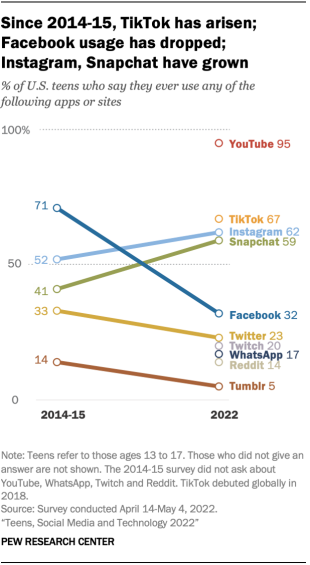
Facebook use among teens dropped from 71% in 2014-15 to 32% in 2022. Twitter and Tumblr also experienced declines in teen users during that span, but Instagram and Snapchat saw notable increases.
TikTok use is more common among Black teens and among teen girls. For example, roughly eight-in-ten Black teens (81%) say they use TikTok, compared with 71% of Hispanic teens and 62% of White teens. And Hispanic teens (29%) are more likely than Black (19%) or White teens (10%) to report using WhatsApp. (There were not enough Asian teens in the sample to analyze separately.)
Teens’ use of certain social media platforms also varies by gender. Teen girls are more likely than teen boys to report using TikTok (73% vs. 60%), Instagram (69% vs. 55%) and Snapchat (64% vs. 54%). Boys are more likely than girls to report using YouTube (97% vs. 92%), Twitch (26% vs. 13%) and Reddit (20% vs. 8%).
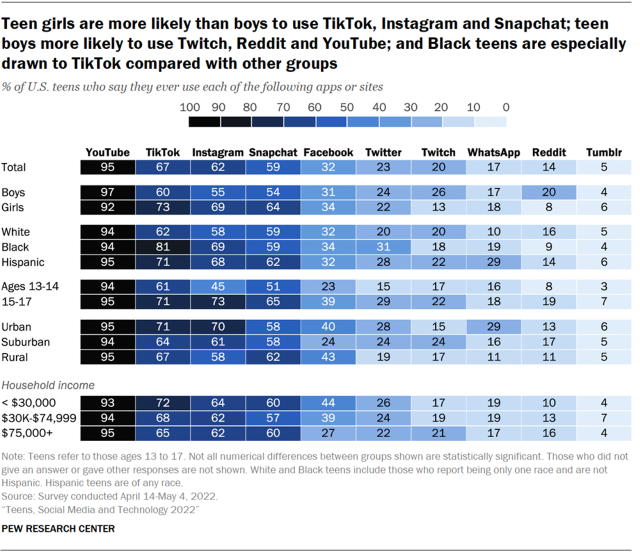
Majorities of teens use YouTube and TikTok every day, and some report using these sites almost constantly. About three-quarters of teens (77%) say they use YouTube daily, while a smaller majority of teens (58%) say the same about TikTok. About half of teens use Instagram (50%) or Snapchat (51%) at least once a day, while 19% report daily use of Facebook.
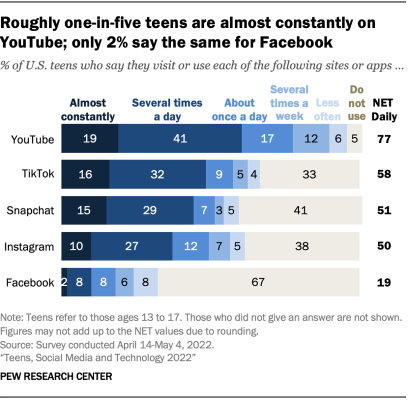
Some teens report using these platforms almost constantly. For example, 19% say they use YouTube almost constantly, while 16% and 15% say the same about TikTok and Snapchat, respectively.
More than half of teens say it would be difficult for them to give up social media. About a third of teens (36%) say they spend too much time on social media, while 55% say they spend about the right amount of time there and just 8% say they spend too little time. Girls are more likely than boys to say they spend too much time on social media (41% vs. 31%).
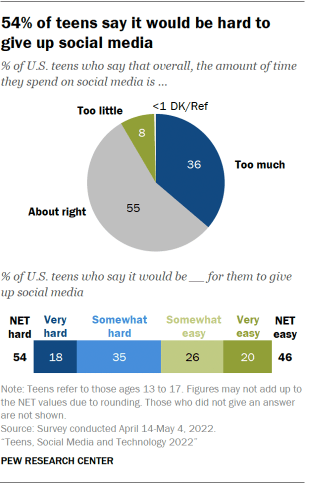
Teens are relatively divided over whether it would be hard or easy for them to give up social media. Some 54% say it would be very or somewhat hard, while 46% say it would be very or somewhat easy.
Girls are more likely than boys to say it would be difficult for them to give up social media (58% vs. 49%). Older teens are also more likely than younger teens to say this: 58% of those ages 15 to 17 say it would be very or somewhat hard to give up social media, compared with 48% of those ages 13 to 14.
Teens are more likely to say social media has had a negative effect on others than on themselves. Some 32% say social media has had a mostly negative effect on people their age, while 9% say this about social media’s effect on themselves.
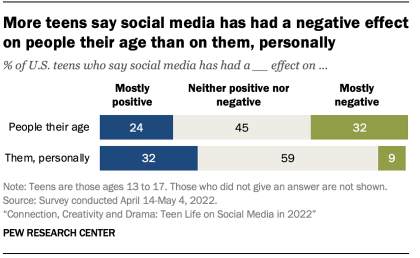
Conversely, teens are more likely to say these platforms have had a mostly positive impact on their own life than on those of their peers. About a third of teens (32%) say social media has had a mostly positive effect on them personally, while roughly a quarter (24%) say it has been positive for other people their age.
Still, the largest shares of teens say social media has had neither a positive nor negative effect on themselves (59%) or on other teens (45%). These patterns are consistent across demographic groups.
Teens are more likely to report positive than negative experiences in their social media use. Majorities of teens report experiencing each of the four positive experiences asked about: feeling more connected to what is going on in their friends’ lives (80%), like they have a place where they can show their creative side (71%), like they have people who can support them through tough times (67%), and that they are more accepted (58%).
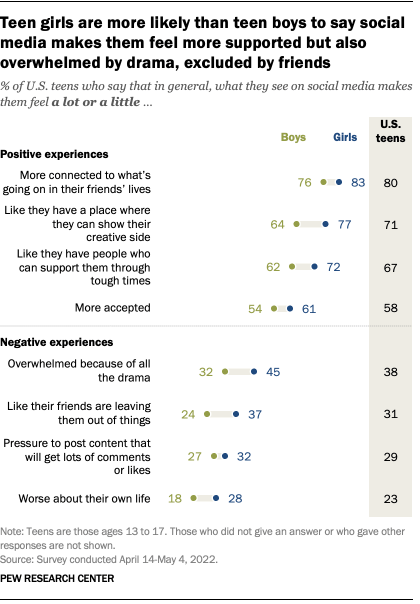
When it comes to negative experiences, 38% of teens say that what they see on social media makes them feel overwhelmed because of all the drama. Roughly three-in-ten say it makes them feel like their friends are leaving them out of things (31%) or feel pressure to post content that will get lots of comments or likes (29%). And 23% say that what they see on social media makes them feel worse about their own life.
There are several gender differences in the experiences teens report having while on social media. Teen girls are more likely than teen boys to say that what they see on social media makes them feel a lot like they have a place to express their creativity or like they have people who can support them. However, girls also report encountering some of the pressures at higher rates than boys. Some 45% of girls say they feel overwhelmed because of all the drama on social media, compared with 32% of boys. Girls are also more likely than boys to say social media has made them feel like their friends are leaving them out of things (37% vs. 24%) or feel worse about their own life (28% vs. 18%).
When it comes to abuse on social media platforms, many teens think criminal charges or permanent bans would help a lot. Half of teens think criminal charges or permanent bans for users who bully or harass others on social media would help a lot to reduce harassment and bullying on these platforms.
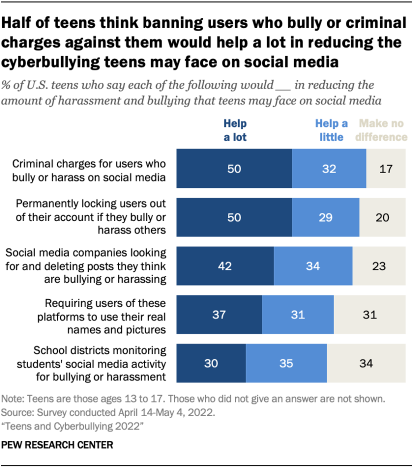
About four-in-ten teens say it would help a lot if social media companies proactively deleted abusive posts or required social media users to use their real names and pictures. Three-in-ten teens say it would help a lot if school districts monitored students’ social media activity for bullying or harassment.
Some teens – especially older girls – avoid posting certain things on social media because of fear of embarrassment or other reasons. Roughly four-in-ten teens say they often or sometimes decide not to post something on social media because they worry people might use it to embarrass them (40%) or because it does not align with how they like to represent themselves on these platforms (38%). A third of teens say they avoid posting certain things out of concern for offending others by what they say, while 27% say they avoid posting things because it could hurt their chances when applying for schools or jobs.
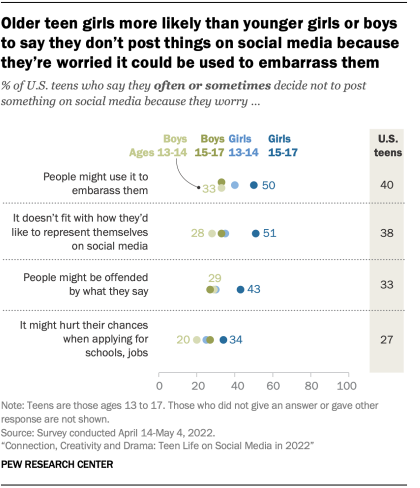
These concerns are more prevalent among older teen girls. For example, roughly half of girls ages 15 to 17 say they often or sometimes decide not to post something on social media because they worry people might use it to embarrass them (50%) or because it doesn’t fit with how they’d like to represent themselves on these sites (51%), compared with smaller shares among younger girls and among boys overall.
Many teens do not feel like they are in the driver’s seat when it comes to controlling what information social media companies collect about them. Six-in-ten teens say they think they have little (40%) or no control (20%) over the personal information that social media companies collect about them. Another 26% aren’t sure how much control they have. Just 14% of teens think they have a lot of control.
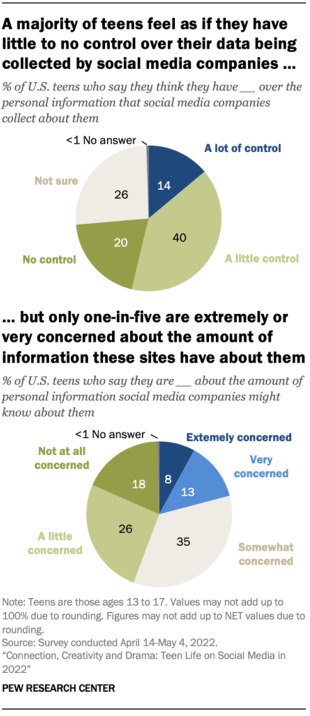
Despite many feeling a lack of control, teens are largely unconcerned about companies collecting their information. Only 8% are extremely concerned about the amount of personal information that social media companies might have and 13% are very concerned. Still, 44% of teens say they have little or no concern about how much these companies might know about them.
Only around one-in-five teens think their parents are highly worried about their use of social media. Some 22% of teens think their parents are extremely or very worried about them using social media. But a larger share of teens (41%) think their parents are either not at all (16%) or a little worried (25%) about them using social media. About a quarter of teens (27%) fall more in the middle, saying they think their parents are somewhat worried.
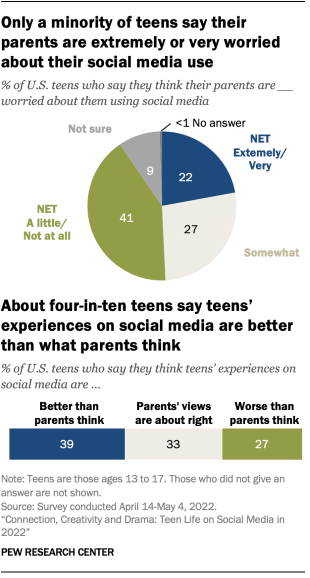
Many teens also believe there is a disconnect between parental perceptions of social media and teens’ lived realities. Some 39% of teens say their experiences on social media are better than parents think, and 27% say their experiences are worse. A third of teens say parents’ views are about right.
Nearly half of parents with teens (46%) are highly worried that their child could be exposed to explicit content on social media. Parents of teens are more likely to be extremely or very concerned about this than about social media causing mental health issues like anxiety, depression or lower self-esteem. Some parents also fret about time management problems for their teen stemming from social media use, such as wasting time on these sites (42%) and being distracted from completing homework (38%).
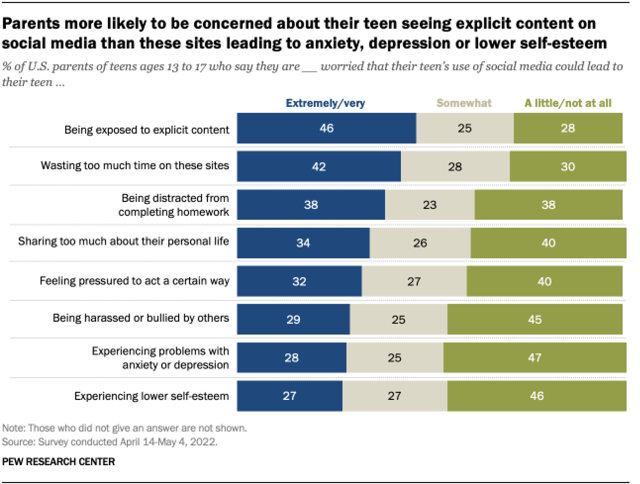
Note: Here are the questions used for this report, along with responses, and its methodology .
CORRECTION (May 17, 2023): In a previous version of this post, the percentages of teens using Instagram and Snapchat daily were transposed in the text. The original chart was correct. This change does not substantively affect the analysis.
- Age & Generations
- Age, Generations & Tech
- Internet & Technology
- Platforms & Services
- Social Media
- Teens & Tech
- Teens & Youth

How Teens and Parents Approach Screen Time
Who are you the art and science of measuring identity, u.s. centenarian population is projected to quadruple over the next 30 years, older workers are growing in number and earning higher wages, teens, social media and technology 2023, most popular.
1615 L St. NW, Suite 800 Washington, DC 20036 USA (+1) 202-419-4300 | Main (+1) 202-857-8562 | Fax (+1) 202-419-4372 | Media Inquiries
Research Topics
- Coronavirus (COVID-19)
- Economy & Work
- Family & Relationships
- Gender & LGBTQ
- Immigration & Migration
- International Affairs
- Methodological Research
- News Habits & Media
- Non-U.S. Governments
- Other Topics
- Politics & Policy
- Race & Ethnicity
- Email Newsletters
ABOUT PEW RESEARCH CENTER Pew Research Center is a nonpartisan fact tank that informs the public about the issues, attitudes and trends shaping the world. It conducts public opinion polling, demographic research, media content analysis and other empirical social science research. Pew Research Center does not take policy positions. It is a subsidiary of The Pew Charitable Trusts .
Copyright 2024 Pew Research Center
Terms & Conditions
Privacy Policy
Cookie Settings
Reprints, Permissions & Use Policy
Spring Showcase of Student Research Coming Soon
Written by Staff
April 22, 2024
1536 Hewitt Ave
Saint Paul, MN 55104
General Information
Undergraduate Admission
Public Safety Office
Graduate Admission
ITS Central Service Desk
© 2024 Hamline University
In association with Mitchell | Hamline School of Law ®. Mitchell Hamline School of Law ® has more graduate enrollment options than any other law school in the nation.
- On-Campus Transfer
- Online Degree Completion
- International
- Admitted Students
- How to Apply
- Grants & Scholarships
- First-Year and Transfer Aid
- Online Degree Completion Aid
- Graduate Aid
- International Aid
- Military & Veteran Aid
- Undergraduate Tuition
- Online Degree Completion Tuition
- Graduate Tuition
- Housing & Food Costs
- Net Price Calculator
- Payment Info
- Undergraduate
- Continuing Education
- Program Finder
- College of Liberal Arts
- School of Business
- School of Education & Leadership
- Mitchell Hamline School of Law
- Academic Bulletin
- Academic Calendars
- Bush Library
- Registration & Records
- Study Away & Study Abroad
- Housing & Dining
- Counseling & Health
- Service, Spiritual Life, & Recreation
- Activities & Organizations
- Diversity Resources
- Arts at Hamline
- Meet Our Students
- The Neighborhood
- The Hamline Academic Experience
- Student Research Opportunities
- Paid Internships
- Career Development Center
- Alumni Success Stories
- Center for Academic Success & Achievement
- Writing Center
- Why Hamline?
- Mission & History
- Fast Facts and Rankings
- University Leadership
- Diversity, Equity & Inclusion
- Alumni and Donors
- Request Info
An arthritis drug helps old dogs, but some owners worry about side effects
Around the country, veterinarians are prescribing a breakthrough new arthritis drug for dogs — Librela — which is helping aging pets get moving again by easing the aches and pains of osteoarthritis.
Ana Maria Cepeda, a veterinarian at North River Animal Hospital in Parrish, Fla., said her first patient was her 14-year-old pit bull mix who in the past has relied on a concoction of pain medication and supplements to cope with severe arthritis and joint issues. “It showed excellent promise on my own dog,” she said. “That gave me more confidence to start trying it in other dogs.”
But not everyone is convinced. Fears about a range of side effects have spread rapidly on social media. A Facebook group shares stories from pet owners alleging that after being given the drug, their dogs had trouble walking or suffered kidney failure . An online petition has been circulating pushing to recall the drug until more study is done. The Food and Drug Administration says its reviewing reports of adverse events.
Veterinarians and the drugmaker say Librela has been shown to be safe and effective. A variety of factors may explain concerns about side effects, including the fact that the drugs are often used in older dogs, who may have a range of health issues.
We spoke to experts about Librela. Here’s what to know.
What is Librela and how does it work?
Librela, made by Zoetis, is the brand name for a monthly injectable drug to treat canine osteoarthritis , a condition that affects an estimated 80 percent of all dogs 8 years or older and as many as 35 percent of dogs of all ages. The drug is an anti-nerve growth factor monoclonal antibody.
Get Well+Being tips straight to your inbox

The drug’s active ingredient is called bedinvetmab, a monoclonal antibody designed to target nerve growth factor, or NGF, a naturally produced protein that’s important for fetal and early development of the nervous system. In adulthood, NGF plays a role in pain transmission and the release of pro-inflammatory molecules. It’s found in high levels in dogs with osteoarthritis.
Librela works by neutralizing NGF in the joint, essentially shutting down the pain pathway and lowering the overall amount of NGF produced. “It reduces how many signals are going to the brain saying, ‘Hey, this hurts,’” said Katie Bennett, an anesthesia and pain management specialist at the Veterinary Specialty Center in Bannockburn, Ill. It also helps alleviate swelling, which causes discomfort.
It’s recommended that dogs receive a minimum of two doses 28 days apart to determine if it can help reduce their pain.
How long has Librela been available?
Librela launched in the United States in October , but it has been used in Europe for the last three years. A sister drug, Solensia, also by Zoetis, has been used to treat osteoarthritis in cats since 2022.
What are the known side effects?
According to Zoetis , side effects can include bacterial skin infections, dermatitis and renal and urinary disorders, including urinary tract infections. In Europe, elevated blood urea nitrogen, which may indicate a kidney issue, was a side effect.
More than 12 million doses of Librela have been sold globally over the last three years, and a fraction of the dogs using Librela (less than 0.20 percent) have experienced “an adverse event,” said Robert Polzer, president of research and development at Zoetis.
Polzer described Librela as “a very safe product.” The company takes adverse events “very seriously,” Polzer said, and continues to collect and analyze data. “To date, we haven’t seen any signals emerge as far as causation between Librela” and the negative outcomes being reported, he said.
“Every medication, whether a human or companion animal medication, has the potential for risk and adverse events,” Polzer said. “Certainly for any pet owner who’s had that experience with their pets, we are quite empathetic.”
On social media, dog owners say their pups’ mobility appeared to decline after using the drug, citing hind leg paralysis in some cases and an inability to walk. Others say their dogs experienced anorexia, lost control of their bowels or experienced kidney issues after using the drug.
Veterinarians said any adverse events should be reported. But they emphasize the drug’s largely positive results.
How much research has been conducted on Librela?
Two clinical trials in the United States and Europe recruited a total of 559 dogs and compared Librela with a placebo for three months each. Neither the dog owners nor the veterinary clinic personnel administering the doses knew if a pet was receiving the real treatment or a placebo.
In the U.S. study , 47.4 percent of dogs receiving Librela showed improvement after the first shot based on owner assessments, compared with 36.6 percent in the placebo group. In the European study , 43.5 percent improved after the first shot, compared with 16.9 percent on placebo. In both studies, the improvements were statistically meaningful. Adverse events were similar in the treatment and placebo groups. After three months of treatment in the European study, 89 dogs in the Librela group (63 percent) had responded positively based on owner and veterinarian assessments, and continued the treatment in a six-month open label phase of the study.
Anecdotally, veterinarians report success with the drug. Union Veterinary Clinic in Washington, D.C., has administered Librela to 49 dogs since October, and the majority are routinely receiving shots, according to Allison Gross, veterinarian and co-owner of the practice. Angell Animal Medical Center in Boston has administered approximately 350 shots, with largely positive results, said Susan O’Bell, veterinarian and internal medicine service director at Angell.
What animals should be given the drug?
Patient selection is important, vets say. The drug should only be prescribed to healthy dogs diagnosed with osteoarthritis and is not recommended for dogs with kidney or neurological issues. The drug is not recommended for dogs who have limping or lameness from another cause, such as a cruciate tear, bone tumors or back or disc injuries. Librela is not recommended for dogs under 12 months, who are pregnant or lactating.
Most veterinarians recommend bloodwork, a urinalysis and possibly other diagnostic tests before prescribing. “A lot is dependent too on the conversations with the client and what their ultimate goal is,” Cepeda said. “Some people, it’s a quality-of-life issue, some people have difficulty medicating, and some people have tried everything under the sun and are desperate for something else.”
Osteoarthritis is a progressive disease, and vets say controlling chronic pain requires time and patience. See how your dog responds to Librela, and discuss with your vet lowering the dosage of other medications.
“It is not a quick fix, not a magic bullet,” Bennett said. “Clients will have to work at it for a couple of months to learn a sweet spot.”
Weight management, water therapy, physiotherapy, laser treatments, acupuncture and a number of other therapeutics can collectively help manage not just joint pain but the disease’s overall effect on the body. “This is the long haul,” O’Bell said. Librela is “one more thing we have in our arsenal.”
How do you know if the drug is working?
Bennett asks owners to keep a daily journal of their dog’s progress and provides owners with a worksheet to measure improvement. Veterinarians suggest taking pictures and videos documenting changes in your dog’s body language, gait and demeanor.
Vets recommend trying two injections over two months before discontinuing Librela, which may not work for every patient. Some patients at Angell in Boston stopped Librela because owners did not see any big improvements, O’Bell said.
Bennett took her own senior dog off Librela after she developed a urinary tract infection. Not every dog will have a miraculous turn around, veterinarians caution. For some, the drug’s efficacy eventually wears off.
For dogs who regain their spark and spunk, experts advise easing them back into play. “Some dogs have become so active they injure themselves, because they go from not moving much at all to running around,” Gross said.
Alexandra E. Petri is a freelance writer based in New York who has worked for the Los Angeles Times and the New York Times. Petri is a two-time reporting fellow with the International Women’s Media Foundation.
Do you have a fitness question? Email [email protected] and we may answer your question in a future column.
Read more from Well+Being
Well+Being shares news and advice for living well every day. Sign up for our newsletter to get tips directly in your inbox.
Are you taking your meds wrong ? Many patients make these common mistakes.
Centenarians give their advice about everything.
The wall sit is a simple exercise that can lower your blood pressure.
Tart cherries — more specifically, tart cherry juice — may help with inflammation and pain.
Do you self-sabotage ? Here’s how to stop.
- Want to run a fall marathon? It’s time to pick a training plan for your goals. April 10, 2024 Want to run a fall marathon? It’s time to pick a training plan for your goals. April 10, 2024
- How to start tai chi April 5, 2024 How to start tai chi April 5, 2024
- Are walking pads worth it? Why I’m never leaving my desk treadmill. April 4, 2024 Are walking pads worth it? Why I’m never leaving my desk treadmill. April 4, 2024


IMAGES
VIDEO
COMMENTS
Social work researchers will send out a survey, receive responses, aggregate the results, analyze the data, and form conclusions based on trends. Surveys are one of the most common research methods social workers use — and for good reason. They tend to be relatively simple and are usually affordable.
Social work research means conducting an investigation in accordance with the scientific method. The aim of social work research is to build the social work knowledge base in order to solve practical problems in social work practice or social policy. Investigating phenomena in accordance with the scientific method requires maximal adherence to ...
5.01 (d): Social workers should contribute to the knowledge base of social work and share with colleagues their knowledge related to practice, research, and ethics…. 5.02 (a) Social workers should monitor and evaluate policies, the implementation of programs, and practice interventions. 5.02 (b) Social workers should promote and facilitate ...
workers deliver their practice agenda and in many ways good research and good social work are synonymous. D'Cruz and Jones (2004: 2) write that: We teach research to social work students because we believe that social work practice is more likely to be effective when social workers are able to draw on and evaluate previ-ous research. As a ...
Abstract This article traces themes over time for conducting social work research to improve social work practice. The discussion considers 3 core themes: (a) the scientific practitioner, including different models for applying this perspective to research and practice; (b) intervention research; and (c) implementation science. While not intended to be a comprehensive review of these themes ...
Social Work Research publishes exemplary research to advance the development of knowledge and inform social work practice. Find out more. Advertisement. Latest articles Evaluation of Social Interventions with People with Disabilities: A Systematic Literature Review
The social work profession should take action to address and further research the research-practice disconnect by establishing a clear definition and aims of social work research, and training academics in effective research-to-practice translational methods.
We will then ask whether research in social work is or ought to be marked by particular values. In closing, we will ask in what sense social work research is a field with a distinctive identity that demarcates it from other fields. Rather than offer up a catalogue of ready-reference definitions of 'science', 'research', 'social work ...
This textbook was created to provide an introduction to research methods for BSW and MSW students, with particular emphasis on research and practice relevant to students at the University of Texas at Arlington. It provides an introduction to social work students to help evaluate research for evidence-based practice and design social work research projects.
Social work research occurs at the micro-, meso-, and macro-level. Intuition is a powerful, though limited, source of information when making decisions. All human thought is subject to errors in thinking and reasoning.
Social Work Research publishes exemplary research to advance the development of knowledge and inform social work practice. Widely regarded as the outstanding journal in the field, it includes analytic reviews of research, theoretical articles pertaining to social work research, evaluation studies, and diverse research studies that contribute to knowledge about social work issues and problems.
set research apart. First, social research is . systematic; that is, the researcher devel-ops a plan of action before beginning the research. Second, social research involves . data, which are the pieces of information gathered from primary sources. This is what makes it . empirical —based not on ideas or theory but on evidence from the real ...
work of existing social work practitioners and researchers. It will specify contemporary challenges with a particular focus on how to embrace social workers "in the trenches" as valued partners and producers in the research process. The social work literature is replete with examples of social work research conducted to inform practice ...
This is a statement on the commitment of social work to humanitarian values and the promotion of social change. It provides the nucleus from which issue and permeate the six key roles of social work, and any social work endeavour. what's distinctive abOut sOcial wOrk research? 01-Hardwick & Worsley-4042-CH-01.indd 1 15/06/2010 12:59:37 PM
The Journal of Social Work is a forum for the publication, dissemination and debate of key ideas and research in social work. The journal aims to advance theoretical understanding, shape policy, and inform practice, and welcomes submissions from all … | View full journal description. This journal is a member of the Committee on Publication ...
So, research is important to social work because it helps us be effective! According to the NASW, research in social work helps us: Assess the needs and resources of people in their environments. Evaluate the effectiveness of social work services in meeting peoples needs. Demonstrate relative costs and benefits of social work services.
The history of social work education may have also contributed to making it difficult for those teaching on university social work courses to engage routinely in research (Orme and Powell, 2007).
Because most social workers don't become researchers or practitioner-researchers, students feel like a research methods class is a waste of time. Social workers play an important role in creating new knowledge about social services, as presented in our previous discussion of evidence-based practice and the use of research methods.
Research on Social Work Practice (RSWP), peer-reviewed and published eight times per year, is a disciplinary journal devoted to the publication of empirical research concerning the assessment methods and outcomes of social work practice. Intervention programs covered include behavior analysis and therapy; psychotherapy or counseling with individuals; case management; and education.
The report from the symposium, "Partnerships to Integrate Evidence-Based Mental Health Practices into Social Work Education and Research," was prepared by the Institute for the Advancement of Social Work Research (IASWR) under contract to NIMH. Portions of this page are adapted from a report and the briefing paper developed by IASWR in ...
A Bachelor's degree in social work is the minimum requirement for most entry-level social work positions. However, many research social work positions require a Master's degree in social work. Gain relevant work experience and develop research skills. You can also pursue a DSW or PhD to further your knowledge and expertise.
Social workers who engage in action research never just go it alone; instead, they collaborate with the people who are affected by the research at each stage in the process. In action research, stakeholders, particularly those with the least power, are consulted on the purpose of the research project, research questions, design, and reporting ...
JongSerl Chun, Ph.D., is a Professor in the Department of Social Welfare at Ewha Womans University, where she also assumes the pivotal role of Director at the Institute for Social Work Research, located in Seoul, South Korea.With a profound commitment to advancing social welfare practices and research, Dr. Chun's scholarly pursuits encompass a wide array of critical topics, notably focusing ...
Today, Portland State University announced its 2024 awards for excellence in research, mentoring, and research administration.PSU's Research Awards acknowledge faculty who exhibit exceptional research, scholarship, creativity, and commitment to the success of PSU students, and recognize one research administrator who makes an outstanding contribution to the production of research at the ...
Print Friendly. A small delegation from the UNC School of Social Work visited the growing rural town of Solwezi (population 90,000) in the North-Western Province of Zambia in March. They came to learn about the impact of local women's savings and credit groups and their financial literacy training. The trip was coordinated by Gina Chowaand ...
A considerable amount of survey research in social work, and in several social science disciplines and allied fields (e.g., education and public health) is devoted to measuring a construct with a high degree of validity and reliability. Validity refers to ensuring that the question(s) do measure the construct they are purported to measure, and ...
Luke Kertcher, an MSSW student in the Administration and Policy Practice (APP) concentration at the Steve Hicks School of Social Work (SHS), has been selected as the recipient of the NASW TX Capital Area Branch's Social Work Student of the Year award. "As social workers, we deeply value individuals who demonstrate unwavering commitment to community service and exemplary leadership ...
Girls are more likely than boys to say it would be difficult for them to give up social media (58% vs. 49%). Older teens are also more likely than younger teens to say this: 58% of those ages 15 to 17 say it would be very or somewhat hard to give up social media, compared with 48% of those ages 13 to 14. Teens are more likely to say social ...
Hamline students in all fields--humanities and natural sciences, fine arts and social sciences, education and business--do exciting research and creative work as part of their coursework. Stop by and celebrate with us! A link to the full program can be found here. Sincerely, Laura Dougherty and Letitia Basford, co-Directors of Honors; Ryan ...
Librela, made by Zoetis, is the brand name for a monthly injectable drug to treat canine osteoarthritis, a condition that affects an estimated 80 percent of all dogs 8 years or older and as many ...